Home » Construction Services (Page 4)
Category Archives: Construction Services
Roofer’s Jobs and Qualities
Roofer is a career field that is an excellent option for individuals who enjoy building and working with their hands. Roofers have the skills and knowledge to fix roofs of all types. They also use various materials, such as metal, wood, or tile, to construct, repair, and install roofs. A roofer also specializes in emergency roofing and can be hired for various residential and commercial needs.

The best roofers are comfortable working on high-rise buildings and should have excellent maths and English skills. In addition, they must be able to read a building plan. They will also be good with their hands. As a roofing job, you’ll be working at a height and with a variety of materials. You’ll be working in the most extreme weather conditions, and you’ll be exposed to a variety of materials.
While roofers typically install new roofs, they also repair or replace damaged ones. To avoid water damage, roofers use various materials, such as asphalt, metal, and concrete. Roofing contractors also specialize in low-slope, steep-slope, and sustainable roofs. Besides installing new roofs, they also conduct regular maintenance and inspections. Ultimately, a roofer’s job is to keep a building safe and functional.
A roofer must understand that mistakes are bound to happen. Even the best roofing companies make mistakes from time to time. If they leave trash or damaged areas on the roof, that’s a sign of a poor job. A quality company will take care of any issues before they become problems. The roofer’s job will never cause any harm to your home siding or landscaping. They should also ensure that they don’t damage your windows or other parts of your home.
In addition to installing and repairing roofs, roofers also install metal flashing on steep-sloped structures. For example, they install step flashing around vent pipes and install a waterproof bitumen layer on steep-sloped roofs. A good roofing contractor will also place metal flashing around chimneys. And they’ll nail down roofing felt to cover the entire roof. So if you’re looking for a new roof for your home, consider hiring a roofing contractor in Irving.
If you’re looking for a roofer, you’ll need to find one with experience and a good reputation. In addition, you’ll want to find a licensed and insured roofing contractor or a general contractor who also works on roofs. When hiring a roofing contractor, make sure to ask them about their training and if they use subcontractors or employ employees. If you’re not sure, ask if the company hires a general contractor, as this will ensure that they are a licensed roofer.
Among all occupations, roofers are the most likely to suffer from injuries and illnesses. Although most people can install asphalt shingles, not all of them have experience with different styles. Many factors can make it safer for a roofer to work with various types of roofing materials. A general rule of thumb is that the more experience a roofer has, the higher the salary. It would be best if you also were sure to check references before letting a contractor work on your roof.
Roofing is a job that requires a lot of tools and experience. A qualified roofing contractor will know how to install different types of roofing materials and will provide you with a free estimate. You should always follow these guidelines to ensure that the roof is installed correctly and safely. If you’re hiring a professional, you’ll be in good hands. When choosing a roofer, make sure to choose someone with the proper training and experience.
Because roofing is usually a seasonal profession, roofers are rarely on the job during colder months. However, they are often required to work outdoors in all kinds of weather, from cold to hot. There’s also the risk of falling, as roofers have to be careful not to hurt themselves. Despite these risks, however, they must have an excellent balance to do their jobs safely. A good balance and the ability to climb high are essential.
50+ New Product Updates for Autodesk Construction Cloud
Discover the latest updates to Autodesk’s construction software
Our product team continues to pinpoint valuable ways to improve your favorite Autodesk products. I’m excited to share the launch of over 50 new feature releases and enhancements across Autodesk Construction Cloud products.
From creating higher quality designs to speeding up RFI workflows, the latest product updates within Autodesk Construction Cloud can be found below.
Jump to releases by product:
-
- Autodesk Construction Cloud Unified Platform
- Autodesk Build
- Autodesk BIM Collaborate
- Autodesk Takeoff
- BuildingConnected
- Bid Board Pro
- BIM 360
- Assemble
Autodesk Construction Cloud Unified Platform

* = features on both Autodesk Construction Cloud unified platform & BIM 360
Dashboards | Additional Partner Cards
Both Autodesk Construction Cloud Unified Platform and BIM 360 users now see new partner cards for Aespada, DAQS.io, Embneusys, Geometrid, Oculo, Pronovos, Safe Site Check In, Structshare, Viact.ai, and WakeCap.
Dashboards | Send Dashboard as Reports*
Both Autodesk Construction Cloud unified platform and BIM 360 users can now share data from a dashboard within Insight as a PDF report to any external team members. A great example of this is if a general contractor wanted to share a dashboard view with an owner who did not have an account. This broadens visibility into project data and allows teams to create custom dashboards and easily share relevant views. Note: PDF reports of dashboards do not include partner cards in this initial release.
Dashboards | Unified Account Level UI Enhancements
From within the Executive Overview dashboards within Insight, both Autodesk Construction Cloud unified platform and BIM 360 users now see a consistent UI to help indicate that all projects shown on this overview list are pulled from projects across both BIM 360 and ACC. This ensures that executives see a holistic view of all projects, regardless of the product used, and help improve the migration experience.
Desktop Connector | Non-Conforming File Validation*
Autodesk Construction Cloud unified platform and BIM 360 users now have the ability to select specific files, and put them through the naming validation tool to rename them in order to meet the project’s naming standard in Docs.
Desktop Connector | Right-click to Rename Files*
For any file, a user be able to right click and rename a file from Desktop Connector without needing to navigate to Docs in the web browser.
Files | Import/Export of Naming Standard*
As a project admin setting up the naming standard on a project, the admin now have the option to export a .xlsx template. They can also make adjustments to the naming standard attributes in MS Excel for ease of use and import to a single project or multiple projects.
Files | Improvements to ISE File & Folder Operations*
Autodesk Construction Cloud unified platform and BIM 360 users can now take advantage of ISO naming standards validation when moving or copying files from enforced to enforced folders and when making a file “current”. Additionally, users can now have their search results be a method to organize files for selection to move or copy to an enforced folder.
Files | Open and Edit DWG with AutoCAD (web app)
From within Files, users can now right click on a .dwg file type to open the drawing within the AutoCAD web app, exposing the use of native AutoCAD tools (viewing and editing). NOTE: Once the file is clicked, a new tab is opened, exposing the AutoCAD web interface.
Library | Search & Sort
There is a new search bar as well as the option to sort within the account level library in the Autodesk Construction Cloud unified platform. This makes it easier to find library components so that teams can use consistent practices and drive standardization across all projects.
Reports | Issue Summary & Issue Detail Filter by Custom Attribute
Autodesk Construction Cloud unified platform users can now filter both the Issue Summary and Issue Detail reports by any custom attribute. This allows teams to run more specific reports that are catered to the way individual companies track issues.
Reports | Logo Management
Project Admins can now customize the logo that shows up on reports by either selecting the account logo or adding in a net new logo. This allows teams to improve the branding of their reports and provide clarity of ownership when sharing reports externally.
Reviews | Add Custom Attributes to Workflows*
The project admin can now add custom attributes to a workflow so that each review initiated has the custom attribute columns for the approve to complete as needed. Note: For BIM 360 users, only projects created after Mar 23, 2021 will have this feature.
Autodesk Build
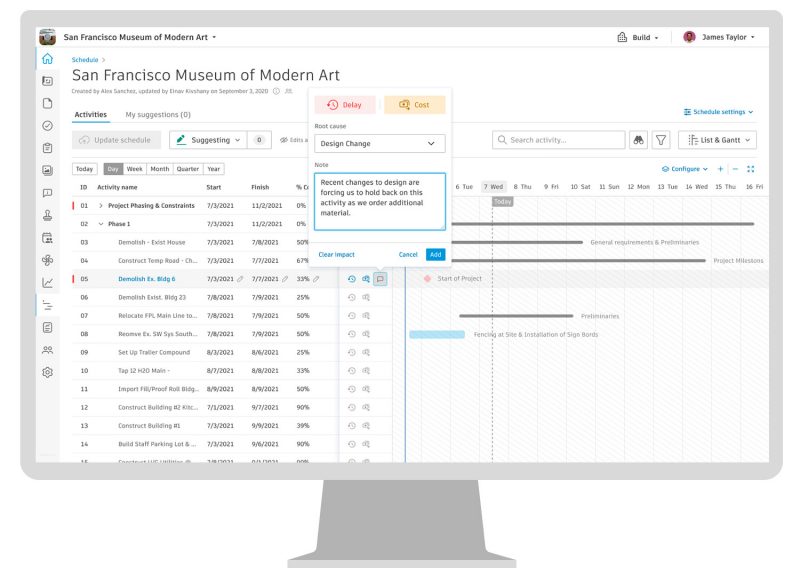
** = features in both Autodesk Build & BIM 360
*** = features in both Autodesk Build & PlanGrid
**** = Autodesk Docs feature (available across all unified products)
***** = features in both Autodesk Build and Autodesk BIM Collaborate
Note: This list is alphabetical. Please see this blog post for Autodesk Build updates organized by workflow.
Assets | Bulk Edits on Web & Mobile
Within Autodesk Build or the PlanGrid Build mobile app, teams can now make bulk edits to a selected group of assets by simply scanning barcodes, QR codes, or NFC tags in sequence. This allows teams to better standardize information and make updates faster.
Assets | NFC Support
In addition to using barcode / QR code scanning within the Assets tool of Autodesk Build, users can now use Near Field Communication technology to pull up detailed asset information. This saves teams time since they can simply set a device within range of the asset, and all asset related information stored within the PlanGrid Build mobile app will instantly appear.
Assets | RFI References
Within the Assets tool flyout panel, teams now see an added reference option for RFI’s. This means that users can link a specific asset to an RFI, connecting information and making it more accessible throughout both the assets and RFI workflow. Note: Mobile functionality will come by the end of the month.
Assets | Schedule References
Within the Assets tool flyout panel, teams now see an added reference option for Schedule. This means that users can link a specific asset to schedule item which gives visibility into where an asset status is in relation to the broader project schedule. Having this level of visibility helps teams better plan and forecast dates. Note: Mobile functionality will come by the end of the month.
Bridge | Automatic Sheet Sharing
As a follow up to the ability to share sheets across accounts (released in July 2021), team members can now specify certain sheets that they are sharing to automatically update when a new version is published. This ensures teams, even if they are from different companies or using different accounts, are always looking at the most up to date sheet information. NOTE: We are currently working on building up the feature functionality of the Bridge tool. Please watch for more enhancements to Bridge in future releases.
Bridge | Import Functionality
Within the ‘Incoming’ tab of Bridge, Autodesk Build users see a new option to ‘Import’ and select sheets from other projects, in which they are also a member, to add to their current project. This improves cross-team and cross-project collaboration, and gives users the ability to surface relevant information to their teams. NOTE: We are currently working on building up the feature functionality of the Bridge tool. Please watch for more enhancements to Bridge in future releases.
Cost Management | Enhanced Document Review Functionality**
Autodesk Build and BIM 360 Cost Management users can open and edit Microsoft Word documents online directly from the document package section within the items details flyout panel, enhancing and accelerating the document review processes.
Cost Management | Expense Photo References
Autodesk Build Cost Management users can now add photo references (e.g., delivery tickets, receipts, etc.) to expenses, ensuring accounting has what they need to process payments.
Cost Management | Home Page**
Autodesk Build and BIM 360 Cost Management users now have access to a new Home Page within Cost Management, displaying an aggregated calendar view of important dates across the system for increased visibility.
Cost Management | Issue to Potential Change Order
Expanding on the ability to create a Potential Change Order (PCO) from an RFI or Submittal Item, Autodesk Build Cost Management users can generate a PCO directly from Issue. Continuing to help teams capture the origin of change orders.
Data Connector | Photos Data
Autodesk Build users can now extract Photos data using the Data Connector. This is especially important to teams tracking quality and safety and wanting to see details around things like how many photos have been captured.
Data Connector | Progress Tracking Data
Autodesk Build users can now extract Progress Tracking data using the Data Connector. This gives teams the ability to create custom dashboards around the use of Progress Tracking and further analyze installation progress of objects on a project using other BI tools.
Handover | Files & Issues in As Built Export
Autodesk Build users can now export Files and Issues data as a part of the As Built Export tool. This adds to the RFI, Submittals, and Sheets download that was currently available and further improves the handover process by saving time, enhancing documentation accuracy, and improving owner satisfaction. Note: Files data will not be available until the end of November.
Issues | Add reference to submittals, forms, PCOs
In addition to the existing ability to link photos, files, RFIs and assets, user can now also add a reference to submittals, forms and PCOs, directly from the issue. This way, teams ensure even more of the issue’s context gets captured.
Meetings | Upload Attachments Directly from Computer*****
Users can upload and remove attachments directly from their PC. Attachments can be added at a meeting or at an item level. This ensures up-to-date information is shared and reviewed during the meeting.
RFIs | Roles and Companies as Users
Within each RFI, all roles and companies can now be specified as a watcher or co-reviewer. This release improves ease of use when creating, editing, or assigning RFIs.
RFIs | Short RFI Creation on Mobile
Users have the option to create an RFI by simply filling out the information for three fields: RFI title, question, and photos. This feature allows users to save time on RFI creation in the field.
RFIs | Step Back From Manager to Subcontractor
This feature allows RFI managers to request additional information from subcontractors by sending the RFI back to the sub. This release helps to speed up the RFI workflow by making sure necessary changes are made in a timely manner.
Schedule | Add Cost reference
Users can reference cost items from the cost management tool to an activity in schedule.
Schedule | Enhanced iOS support
iOS users can filter schedule information by Activity codes/ Outline codes imported from the schedule authoring tools. Allowing teams to find the right information, faster.
Schedule | Suggestions [coming soon]
Users with the right permissions can now submit an update suggestion on an activity to the schedule manager, improving communication across stakeholders. The schedule managers can review, approve or reject the suggestions. The schedule manager must update the master schedule in the schedule authoring tool to ensure the latest schedule is imported into Autodesk Build.
Submittals | Import Enhancements
During the upload process, Autodesk Build users get a new processing loader which can be referred to as a progress bar. This release supports a friendlier and more transparent import process.
Submittals | Project Home Support on Mobile
Users can now view a submittals work status card on iOS & Android. This allows access to critical and actionable information faster from any device at any time.
Submittals | Report Enhancements
From the Submittal tool, users can generate both the detail and summary reports, and have the option to include specific submittal items when exporting the report. Report enhancements now also include a single item report that can be generated from the action menu. Users can also copy a public link to share the report from the panel once the report has been generated. These enhancements allow customers to have more flexibility when exporting submittal reports.
Submittals | Review & Annotate PDF Attachments
Autodesk Build users now can view and annotate submittals, such as adding an approval stamp (image stamp), text, arrow, cloud, highlighter and various shapes directly in Autodesk Build. This enables a faster and more efficient review process.
Submittals | Upload Attachments from Files or from Computer
Autodesk Build users can select up to 10 existing files from Autodesk Docs and attach it to the specific submittal item. Now, Document Management and Project Management workflows are even more connected.
Learn more about this month’s product releases specific to Autodesk Build in this blog post.
Autodesk BIM Collaborate
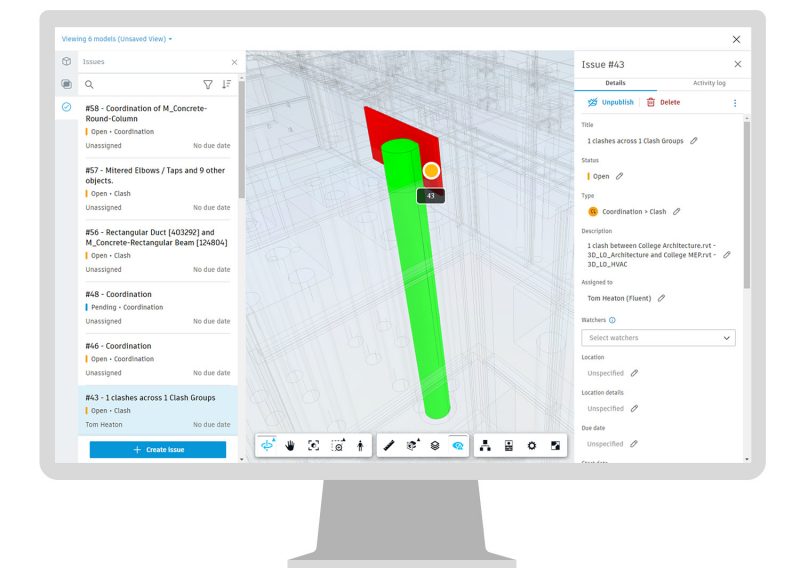
****** = features in both Autodesk BIM Collaborate and BIM 360
Change Analysis | Easier navigation
Design changes are now more easily managed and analyzed with a new experience that allows users to select the models they want to compare and quickly apply filters by discipline, category or modification type (shape, property, transform). Teams now have more control over the changes they decide to focus on and how those changes affect them.
Change Analysis | Review of non-consecutive designs
Previously, architects and engineers who review design changes before consuming them could only review the differences between the new design and the last design. Now, any design from the past can be reviewed alongside the latest.
Go Online | Revit Issues Add-In******
Architects, engineers, and BIM managers using Revit can immediately access issues, clash information, and models from cloud applications like Autodesk BIM Collaborate or Autodesk Docs. When an issue gets resolved in Revit, designers can use this quick link to access related files or check their work against other models using the clash matrix—making it easier to create high quality designs.
Model Coordination | Advanced grouping******
Group clash results with a greater level of granularity with advanced grouping capabilities. Now, clashes can be grouped by any property of a clashing object. Choose standard properties or custom ones to group and organize clashes for faster clearing and resolution.
Model Coordination | IFC, NWC, and VUE File Support******
With the added support of NWC and VUE files and extended support for IFC files for automatic clash detection or model aggregation, Autodesk BIM Collaborate offers greater flexibility for BIM managers, design teams, and trade partners to engage in model coordination.
Autodesk Takeoff
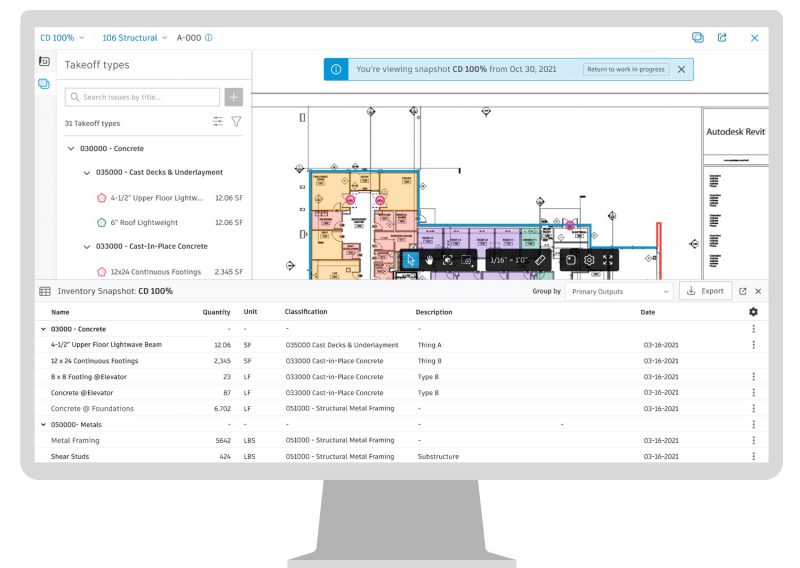
Snapshots
Autodesk Takeoff users can preserve critical information including sheets and/or models along with associated takeoffs and inventory within a project at a given point in time. Users can access saved snapshots to view prior versions of takeoffs and inventory for a specific milestone or other key events. These stored references provide estimators confidence in their work by citing key information critical to the takeoff detail.
Flexible Output for Takeoff Types
Users can assign a code from both primary and secondary classification system to any output (primary or unlimited “additional” outputs) when creating takeoff types. The classification field is now optional, allowing estimators to create takeoffs faster when needed. The outputs not classified are automatically grouped as “unassigned” to make it easier for users to track and reassign later if needed. Each output can be assigned up to 2 classification codes—one from each classification system uploaded.
Inventory Enhancement
Users can view information from both primary and secondary classifications at the same time in the inventory panel. Multiple outputs can be seen together, grouped by takeoff type, when appropriate. A new grouping has been created in the inventory for “unassigned” outputs. Location information is also surfaced in the inventory panel.
Locations Support
Users can assign takeoffs to specific locations created in the “Project Admin” tool so quantities can be assigned accordingly. Whether you are allocating quantities by Floors, Levels, Phases or Zones, locations are a great way to organize your takeoff inventory.
BuildingConnected
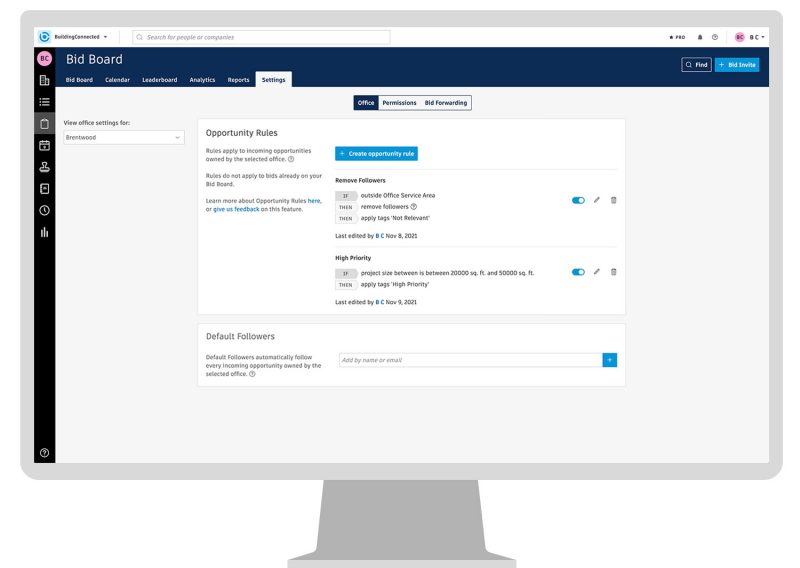
Bid Board Pro
Opportunity Rules
Users can create opportunity rules (“if/then” statements) to help organize opportunities and filter out junk invites by either applying tags or removing followers. This helps to streamline the Bid Board experience and remove unwanted invites automatically.
BIM 360
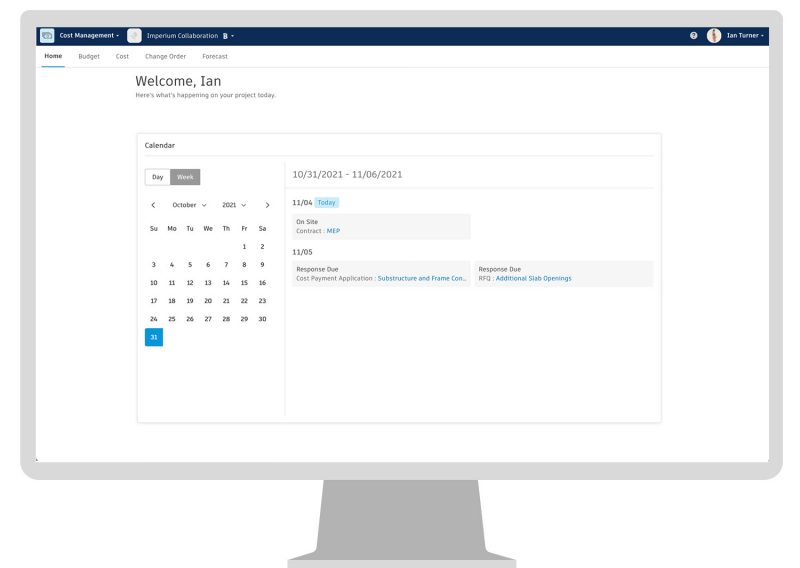
****** = features in both Autodesk BIM Collaborate and BIM 360
Daily Logs | XLS Report from Field Management******
BIM 360 users can now export the activity log of any daily log. The export includes timestamp, user, activity and before after status which makes it a full audit trail useful in case any disputes arise.
Dashboards | Permission Changes******
BIM 360 users can now control permission to view certain dashboards within BIM 360. This helps drive focus for team members and eliminate unnecessary dashboard views. Additionally, it gives more control to Project or Account Admins to filter only relevant information to team members. For more information view the FAQ on our Help Site.
Assemble
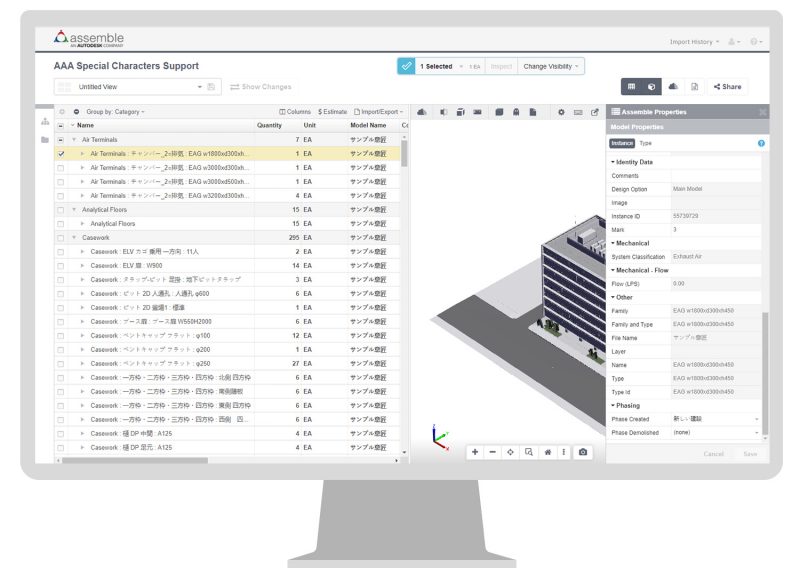
Expanded Support for Special Characters
Assemble has expanded support for Unicode characters for property names and values. Assemble users can now publish model properties names and values with expanded characters from desktop tools as well as Revit models from BIM 360 and Autodesk Docs. Users are also able to sync property values with expanded characters back to Revit.
Model Publishing Improvements
Continuing to build upon the recent enhancement of publishing Revit models from BIM 360 and Autodesk Docs to Assemble without the need of the Revit add-in, Assemble now supports importing Revit Cloud Workshare models as part of the cloud publishing workflow. By leveraging the common data environment, BIM/VDC Managers can ensure that everyone is working from the latest project documents.
Get the latest Autodesk Construction Cloud product updates

The post 50+ New Product Updates for Autodesk Construction Cloud appeared first on Digital Builder.
Digital Builder Podcast Ep 22: How Specialty Contractors Can Navigate Contracts & Get Paid On Time

In a perfect world, a contract should include a clear set of instructions that conveys well-defined expectations to all parties concerned. In reality, it’s often a monster document packed full of legalese that can be difficult to understand. This episode of Autodesk’s Digital Builder podcast addresses the most common challenges with contracts and how simple adjustments can ensure you fully understand what you’re signing. And of course, we cover steps to make sure you’re getting paid on time.
Listen to the episode now
You can also listen to this episode on Apple Podcasts, Spotify, Stitcher, Google Podcasts, and anywhere else you get your podcasts.
On this podcast episode
Today’s guest, Karalynn Cromeens, Owner & Managing Partner at The Cromeens Law Firm, joins the show to share the steps everyone can take to make contracts more straightforward and less contentious.
We discuss:
- The current state of construction contracts
- The difference between secured and unsecured debts
- How to protect yourself when it comes to contracting and payment terms
- Best practices for handling change orders
- Construction technology and the future of contracting and payments
A contract should really be a tool to help everyone in the construction industry; it doesn’t have to be this monster document that you just hold your nose, sign, and hope for the best.” — Karalynn Cromeens
4 tips for navigating contracts and getting paid on time
1. Understand the state of contracts and payment terms in construction
The current state of contracts and payment terms in construction leaves a lot to be desired, says Karalynn.
For starters, construction contracts have become increasingly complex, making it hard for all parties to get on the same page.
“The contract is supposed to be a clear set of instructions just like plans and specs, but it becomes this monster document that nobody understands and it’s not conveying expectations clearly.”
—Karalynn Cromeens, The Cromeens Law Firm
Karalynn also brought up the tendency of the industry to pass liability down the chain when drawing up contracts. Owners pass on certain risks (contractually) to general contractors, who may do the same thing when hiring specialty contractors.
These things are common in the AEC industry, particularly since construction professionals want to protect themselves when possible. However, these practices can create rifts in relationships and result in contentious situations.
For this reason, construction professionals must find better ways to craft and negotiate agreements. This starts with using contracts that people can easily comprehend.
“Let’s have a contract and ensure that everybody knows what it says,” says Karalynn.
She recalls her experience speaking with a fellow attorney who had to go through a 129-page subcontract that could have been cut down to ten pages.
“It’s all repetitive, it’s all legalese and there’s no reason for it. The contract should be a tool to help everyone in the construction industry understand the project’s requirements, deadlines, and terms. It doesn’t have to be this monster document that you just have to hold your nose and sign, then hope for the best.”
Karalynn also emphasizes the importance of negotiating who takes on certain risks and liabilities. “I’m not saying that the subs don’t take any liability or the general contractor doesn’t take any liability from the owner; I’m saying let’s negotiate. Let’s meet in the middle. Which is what it’s supposed to be.”
Taking these steps, states Karalynn, helps parties negotiate more equitable contracts and forge better relationships—something that’s crucial, especially since construction is such a relationship-centric industry.
2. Make sense of your contracts
The shifting of risk and liabilities is a very common practice when drafting contracts. After all, everyone is trying to protect themselves. That said, contracting can be done fairly so that relationships aren’t taken advantage of, and risk isn’t pushed downstream.
As the host of “Quit Getting Screwed,” a podcast that focuses on helping contractors build better businesses, Karalynn is well-versed in construction contracts and she offers valuable advice to help contractors understand the agreements that they’re signing.
Know the different types of contracts
There are different types of contracts drawn up between owners, general contractors, and specialty contractors. According to Karalynn, contractors must understand these various documents and how they relate to each party.
First, there’s the prime contract, which is the agreement that sets the terms between the owner and GC. The GC then hires contractors, which is where the subcontractor agreement comes into play.
This subcontractor agreement often “relegates the terms of the prime contract,” says Karalynn.
“What has happened and what has been happening as long as I’ve been reading subcontracts is on the first page of the subcontract, there’s a line that incorporates the terms of the prime contract. So these subcontractors, specialty contractors, or trade contractors are going to be held responsible and liable to the terms of the prime contract.”
The issue, she says, is that subcontractors often don’t see the prime contract so they don’t know what the document says and they’re unable to negotiate its terms.
Karalynn says it’s important for subcontractors to get ahold of the prime contract so they can understand exactly what they’re agreeing to.
Another common type of agreement is the Guaranteed Maximum Price (GMP) contract.
“What this tries to do is shift the risk of material price increases to the general contractor, and then from the general to the subs.”
The GMP contract can cause challenges if it doesn’t allow contractors to increase what they’re charging when material costs rise. For this reason, contractors need to be careful with the GMP agreement and negotiate terms to protect themselves.
Be aware of the “pay when paid” clause
Karalynn recommends being mindful of the “pay when paid” clause, which essentially means subcontractors won’t get paid until the GC is paid by the owner.
“So if you’re a subcontractor and you do the best outstanding job in the whole world and the GC tells you what a great job you did… That by itself is not enough to get paid if you have a ‘pay when paid clause’. You are relying on something to happen that you have no control over.”
She continues, “the owners [have] to pay the general contractor before the general [contractors have] the obligation to pay you, the sub. So really, if you sign a subcontract with a ‘pay when paid’ clause and you don’t negotiate, you should really have enough cash on hand to float that whole contract amount just in case.”
In these instances, you should negotiate and try to split the risk, says Karalynn.
“You can say, ‘If the GC is not paid by the owner within 30 days and it’s not my fault, you’ll pay me 50% of the payout. At least I can pay for my guys and I can make it a little longer without getting paid.’”
—Karalynn Cromeens, The Cromeens Law Firm
3. Learn how credit works in construction
The construction industry runs on credit. Owners often take out loans to fund projects, and they are extended credit to be able to do that. A similar thing happens with subcontractors, especially those working with a “pay when paid” clause.
As Karalynn puts it, “subcontractors and material suppliers supply the labor, supply the material and wait to get paid. And that is credit. You are owed a debt. So, if you work and wait to get paid you have extended credit.”
To ensure that you get paid, you need to understand the difference between unsecured and secured credit. Unsecured credit means the debt is not tied to any collateral. You can collect on the debt by taking things to court, obtaining a judgment, and finding assets to collect the amount owed.
Secured credit, on the other hand, is backed by collateral. A home mortgage is a common example of secured debt. Mortgage companies let buyers obtain a loan to purchase a house, and they hold the property as collateral.
“A mechanic’s lien works the same way,” says Karalynn. “If you do it right in your state and you file it on a project, you are now a secured creditor. The amount that you’re owed for labor and materials is secured by the property that you supplied them to.”
She adds, “You still have your unsecured debt claim against the GC or whoever hired you, but now you have a security interest in the property to the extent that you’re owed money for labor and materials supplied.”
4. Ensure you’ll be paid on time
While laws vary from one state to the next, there are a number of universal tips that you can implement to negotiate contracts and ensure you get paid on time. Here are Karalynn’s top recommendations.
Don’t just sign a contract—make sure you understand it
Even if you don’t want to negotiate, Karalynn says it’s worth having an attorney or legal professional break down what the contract means. “That way, you know what you’re agreeing to and you know what’s expected.”
At the very least, you must “understand what you’re agreeing to, and then you can go from there,” says Karalynn.
She continues, “Please, don’t just sign the contract. From my experience, the subcontract that comes over is the first offer. It is like paying the sticker price for a car. No one does that. And I think part of why subcontracts are in the state that they are in now, is that attorneys draft things that are the best for their client thinking that there’s going to be a negotiation. But subs were so afraid of not getting the work that they just signed the contracts, and now there’s a standard out there that’s one-sided.”
Get your change order costs covered
Karalynn says subcontractors must understand the change order provision in their contract and then negotiate before signing.
“What I like to do in my contracts is, if we can’t agree on a price, we’ll do costs plus a percentage—e.g., 15%, 10%, or whatever is agreed upon. That way, we don’t have this long, drawn-out negotiation.”
—Karalynn Cromeens, The Cromeens Law Firm
“What I like to do in my contracts is, if we can’t agree on a price, we’ll do costs plus a percentage—e.g., 15%, 10%, or whatever is agreed upon. That way, we don’t have this long, drawn-out negotiation. We just build in, ‘Okay. I’m going to give you a price. If you don’t like it, here’s the alternative.’”
Another tip? Before doing the work, have the actual change order form drafted and ensure that the costs for the work are outlined clearly. You also need to assure that all parties have signed it before working on the changes.
“Where most people get into trouble is that they don’t get it signed or they submit it after they do the work. When that happens, you’re just in somebody’s good graces to sign it for you because you’re really not going to get paid for that extra work if it’s not on a written change order,” says Karalynn.
Account for market volatility
With material prices being so volatile right now, Karalynn says contractors and subcontractors need to account for increases in material and labor costs.
According to her, “you need to put on there that if the material prices escalate more than 2% or 3%, you’re going to be able to change your bid for that.”
“I also have guys that are putting shorter timelines on their bid—like 30 or 60 days—and if it’s not accepted by then, the bid is withdrawn. That’s just because the market is so volatile right now.”
Do an itemized bid
Always do an itemized bid, advises Karalynn. “You don’t want to just bid the whole scope and miss something and then you’re on the hook to do it. Because once you put a bid out there into the world, it is an offer that can be accepted. And once it’s accepted, you’re held liable to those terms.”
Another thing to keep in mind is that your bid can be different from the actual scope of the project. You need to remember that you’re not hired to do your bid, you’re hired to do the scope.
As Karalynn points out, “your bid no longer describes the work you were hired to do. The scope attached to the contract does. If those two things are different, you’re still held to the scope. So one of the things I tell my contractors is to read the scope as if it were a new project and make sure you get the same price.”
Utilize technology to save on attorney fees
Karalynn is all for using technology to help contractors put together contracts and make sure they get paid.
“There are so many great platforms out there that allow you to do everything electronically. A lot of times, you don’t get paid on time because not everything is in there or it’s not submitted correctly so that pushes you back another month. Technology helps eliminate all that. It has everything all in one place.”
Karalynn adds that technology not only helps attorneys do their jobs more efficiently, it could even lower your legal bills.
“I appreciate it so much as a lawyer that I don’t have to go through banker boxes looking for all the paper documents that go with a particular job. If I’m looking for something, I can search by keyword. It saves you so much in attorneys fees too, because I don’t have to spend time searching.”
Final words on contracts and timely payments
Navigating the realm of construction contracts, costs, and risks can be tricky, but understanding these things is key to getting paid on time. Before entering into an agreement, be sure to read and fully understand the terms of the contract, so you can negotiate accordingly.
Doing that is no easy task, which is why Karalynn says it’s extremely helpful to have “an attorney that’s a phone call away.”
“I don’t think people realize how much legal crosses over into the construction world. And often, you need somebody that’s going to answer the phone right away. You can’t wait two days, you can’t wait a week to get an answer. I think an attorney on call that is familiar with construction is a priceless tool in your toolbox.”
New podcast episode every two weeks
Autodesk’s Digital Builder podcast is hosted by me, Eric Thomas. New episodes go live every two weeks.
If you need to learn additional contracting and negotiation tactics, catch the full podcast episode of Digital Builder to hear more from Karalynn.
Listen to the Digital Builder Podcast on:
- Apple Podcasts
- Spotify
- Stitcher
- Google Podcasts
- or wherever you listen to podcasts
The post Digital Builder Podcast Ep 22: How Specialty Contractors Can Navigate Contracts & Get Paid On Time appeared first on Digital Builder.
Scaling for Success in the Plant and Manufacturing Industry Through Standardised Ways of Working
Axalta Coating Systems Ltd are a leading global coatings provider dedicated to the development, manufacturing, delivery, and service of liquid and powder coatings, with their headquarters in Philadelphia, USA. With over 150 years of experience in the coatings industry, they provide their customers with innovative, colourful and sustainable solutions.
Predominantly developing and manufacturing coatings for light and commercial vehicles, industrial and refinish applications; Axalta embraces the latest trends alongside emerging technology and systems to deliver the finest coatings to more than 100,000 customers across the globe. With 46 manufacturing centres across the world, 28 laboratories and a presence in over 130 countries, the team at Axalta are constantly looking at news ways to push boundaries.
Marco Schuh, BIM Manager at Axalta, has worked in the architecture, engineering and construction industry for the last 20 years. In his various roles, Marco has witnessed the vast expansion of computer-aided design first-hand and has seen Business Information Modelling (BIM) use and demand rapidly increase. “For the last five years, I have been focusing on cloud-based project management practices in a BIM environment, so I have seen the application and the technology grow too,” says Marco.
In 2019, Axalta’s plant engineering subsidiary business based in Wuppertal, Germany began exploring how they could move some of their local project data from a local server into the cloud. The team wanted to be able to host and store project documentation centrally in a secure environment but also to learn more about how they could improve, implement, and embed digital workflows for this business unit to aid communication and collaboration.
Standardising ways of working

With many different document management practices happening on the ground for the plant engineering team, ensuring standardised document management processes were implemented smoothly was very important. Alongside this, the team also needed to find a solution that allowed everyone to access the documents they needed wherever, and whenever they needed them.
Working in a plant environment with tight timescales means that the team at Axalta cannot afford to lose project time due to poor communication because of missing project data. The team were already using a server solution for internal documentation, but it limited their ability to successfully access, track and collaborate on documents in a transparent way.
After a period of exploration, Axalta concluded that Autodesk Construction Cloud’s BIM 360 solution was the right technology for Axalta’s needs with a focus on improving communication. To implement the solution successfully and smoothly, Marco partnered with Autodesk’s customer success team and their local reseller partner, Mensch und Maschine Deutschland. It was crucial that the team at Axalta were able to move their interdisciplinary project data into the cloud environment in a seamless way, minimising any disruption to ongoing live projects.
“Our projects are time-critical, so we need smooth, transparent, clear communication and filing to know where project data was stored as we transitioned from our previous system to BIM 360,” Marco reflects.
Creating a comprehensive transition plan

The team at Axalta were aware of the long-term negative impacts that could arise from disruption to ongoing projects, so they created a comprehensive transition plan. The plan, which spanned a 12-month period, involved an elaborated transition process which included a testing and a migration phase. This happened in parallel with Axalta’s ongoing day-to-day regular processes, so the team were managing two ways of working at once. Working in this way helped to minimise any interruptions or delays to ongoing work and allowed the team plenty of time to understand and prepare employees for new ways of working within the team.
To get started, the team at Axalta began their journey with BIM 360 on a large collaborative project which involved several stakeholders – many of which were not directly located on site at Axalta’s plant facility. To ensure all the external collaborators and partners were safely and comprehensively introduced to the solution and the new ways of working, Marco conducted introductory sessions on site. As well as this, Marco and the team created an internal handbook for project team members to use with a complete overview of the BIM 360 project workflows that would be rolled out.
“We worked closely with the team at Autodesk to ensure we transitioned successfully, and this included bi-monthly calls with tech champions, mentorship on workflows for these champions, feedback sessions with Autodesk’s product team as well as ongoing communication on outcome-focused goals,” says Marco.
Internal plant maintenance projects and construction projects for new plants began using BIM 360 for document management and digital workflows. The team began with a focus on document management practices but soon expanded into using other capabilities BIM 360 had to offer. Naming conventions and folder structures were the first areas the team focused on as well as supporting the Computer Aided Design (CAD) teams with how they could digitalise and integrate their processes with BIM 360. This involved training sessions and one-to-one support by Marco as a BIM 360 expert.
“We began exploring the functionality that allowed our teams to make notes and annotations onto our models in BIM 360 which increased accountability, transparency and communication immensely,” says Marco. “Annotating directly on the model meant that we minimised the chance of anything being missed when moving between different platforms and systems.” The team have also looked at what other digital workflows they could expand to use such as issues tracking.
For the team at Axalta, using BIM 360 as their common data environment meant internal communication on projects improved significantly. Marco says: “BIM 360 gives us a single source of truth, transparency between all project stakeholders, and accessibility from anywhere meaning we’re all much better informed during a live project than we were before we started using BIM 360.” For the team, quality has increased dramatically as all project team members can be sure they are accessing one single source of truth. As well as this, standardising the team’s approach to document control and modelling has meant that all project collaborators can be sure they have the most up-to-date and accurate information they need when making important project decisions related to their tasks and activities.
Scaling for success
After a year of testing and using BIM 360 in the plant engineering subsidiary business, the use of BIM 360 is being explored by some of Axalta’s manufacturing, construction, and engineering departments in their locations in Germany.
“Looking to the future, we plan on expanding our use of BIM 360 in plant and engineering even more,” affirms Marco. “We’ve also began integrating further technology into BIM 360 such as our laser scanning workflows and we’re looking to use the BIM 360 Coordinate feature to improve our model coordination processes,” remarks Marco.
For the team at Axalta, implementing BIM 360 to create robust document management processes, digitalising workflows and capturing project progress information in a BIM environment has not only improved team collaboration but delivered better project outcomes. “The most popular features in BIM 360 that our teams are using are the, project management, model coordination and issues management workflows as well as the powerful approval workflows for reviews within document management capabilities which reflects how the quality of our projects are improving through the use of BIM 360,” says Marco. Looking to the future, implementing the use of BIM 360 on more and more projects is the focus for the team as well as harnessing data for better project insights to drive decision-making across the business.
The post Scaling for Success in the Plant and Manufacturing Industry Through Standardised Ways of Working appeared first on Digital Builder.
Did you miss our previous article…
https://www.arizonasolarsociety.com/?p=1243
Behind the Build: Interview with Justin Lipsey, VDC Technical Leader, SSOE

The importance of hard work and thinking big cannot be understated, especially in the world of modern design and construction. These are the very things that lead to growth, innovation, and career success, which is why it’s essential that we strive to embody these traits in our day-to-day lives.
One person who’s doing just that is Justin Lipsey, VDC Technical Leader at SSOE.
Justin started his construction career as a plumbing engineer, and in 2018, proactively made the transition to a more tech-focused role in VDC. He’s achieved quite a lot in just over three years within the VDC realm, including winning SSOE’s Founder’s Award and landing a speaking engagement at Autodesk University.
Justin credits his accomplishments to positive thinking, dedication, and of course, hard work.
We recently caught up with him to discuss his construction journey thus far, as well as what’s next.
Tell us a little bit about SSOE and what you specialize in.
SSOE is an AEC firm specializing mostly in the “engineering” portion of that AEC acronym. We’ve been around for 70-plus years and have business units that touch pretty much every facet of the industry. So, we range from semiconductors all the way to educational projects.
When working at SSOE, you’re actually able to interface with anything you would like. There are loads of opportunities. In my case, I have over a decade of experience as a plumbing designer/engineer. I was in the automotive and manufacturing business unit, and my specialty was siphonic storm drains.
But then I switched over to technology. Now, my role is with the Project Technology department and I’ve been here just over three years. I specialize in all things BIM 360 and ACC (Autodesk Construction Cloud).
I started off just by volunteering and training with pilot projects. And two and a half years later, many of my coworkers call me “BIM Three Lipsey”.
Walk us through your career and what led you to becoming VDC Technical Leader.
I’ve always been into technology and computers, and I like being creative. But sometimes design and engineering projects aren’t creative at all, especially the types of projects I was working on.
So I started looking for ways where I could get into tech but still remain in my industry. A VDC rotation slot happened to open up, and at that time I didn’t really know a great deal about VDC. I just had a very broad idea of what it was.
But I took the leap, and that spiraled into registering point cloud data, laser scanner operation training, and all things reality capture technology. I learned really quickly and I get to work with developers now. I can really say that I’m passionate about this work.
I also got to go to AU in 2019 and just sat with the Forge devs for an entire day. I learned so much just by sitting next to them, talking to people’s managers, and soaking it all up. So VDC led me into the world of construction technology.
The way I see it, technology is like the wild wild west right now. Depending on your job title, you get to make your salary—you get to decide on your duties and tasks. It’s amazing.
What is your proudest accomplishment in your 6 years at SSOE and why?
About a year and a half ago, I wrote down this list of goals. It included things like speaking at AU (Autodesk University) and winning a Founder’s Award, one of our most prestigious awards at SSOE.
I’m proud to say that I hit those goals in about 6 months. I was given the opportunity to speak at the virtual AU last year, where I discussed the topic of AEC product ownership.
There was also the Founder’s Award, which was given to the project team who developed training materials to support the rollout of BIM 360. Before the pandemic hit, we were piloting BIM 360 and trying to understand how to best roll it out. Then COVID happened and there were infrastructure issues immediately. That’s when we made the quick decision that every new project going forward starting January of this year would be in BIM 360.
To make it happen, we needed to develop training materials. I was afforded the ability to utilize all of the beautiful music equipment I have collected over the years and my limited knowledge of video creation and editing. I purchased an iPad app, watched a few YouTube videos, and was able to create over 20 customized training videos for BIM 360. Our team also created a SharePoint site to house all of our training content and other supplementary information. To-date, we have uploaded over 150 pages of tips and tricks, knowledge base articles, and quick reference guides
“One of the most rewarding parts of my job is when I finally get things to click for someone, and they say, ‘Oh, I understand that now! And I’ll share this with my team.’”
Justin Lipsey, VDC Technical Leader, SSOE Group
There were a whole bunch of people who contributed to our training content, so I can’t take all of the credit. Our developers were able to whip up this automation, despite some limitations within the API for BIM 360. They did a bunch of workarounds to get a lot of “ease-of-use” functions out to our users.
I’m proud of all of that. I knocked all my goals out of the park and I think it’s just the power of manifestation—writing things down, and looking at it every day.
As construction evolves, how do you see the role of VDC Leader changing?
Honestly, I think the future is going to be more focused on data analytics, as well as innovation, research, and development.
I am also hoping for more product ownership because, over the next five years, we’re going to need a team of people who understand computational design, algorithms, APIs—all that fun stuff. We’re trying to build that team of people right now and we’re looking to leverage Power BI and dashboarding. We’re trying to figure out how to harvest the data from BIM 360 and our new ERP Microsoft Dynamics to gain the insights we need to make better business decisions. We also want to better visualize that kind of information in a palatable way for our users.
Right now, VDC is more of a manual process. I interface with project teams. I’m doing a lot of the training and tons of research and documentation, but I believe that the future would be similar to how Revit developed. Now, you have Revit power users who do a majority of what a BIM manager used to do 10 or 15 years ago, managing templates, setting up models, etc. This allows BIM managers to focus on more high-level important coordination items.
In the future, it should be the same for VDC. Research and development should come from operations. They should be telling us what they need, what they want, and VDC performs the analysis and evaluates how to best fit it into our tech stack. Then empower them through the use of data to visualize the end goal.
There’s also the learning aspect to the job. BIM 360 and ACC Build have the Insight module, and we’re really trying to utilize that. I think a big part of the future is learning how to use all this data and figure out how to apply it to upcoming projects. Then we can really handpick our clients and projects. That way, we’ll be more profitable and provide the most value.
I also think that product owners and managers will become more prevalent in our industry. Technically, I’m a product owner of BIM 360 right now. We have this amazing automation process that our developers came up with, where you can create a new project in our ERP system, and it spins up a BIM 360 project. It also spins up an Outlook group so they can track their project email. As a product owner, I helped connect the developers to the business by defining what would be the most valuable automation for our project teams.
Being a part of the BIM 360 team, I interface a lot with our users and take feedback to the devs and give them improvement ideas for that automation. And in my eyes, that’s the future. If more of our VDC folks would learn the skills needed for product management and the human side of technology, I would welcome that.
What are the biggest challenges you face in your role? How does technology help you overcome those challenges?
We’re in this digital transformation phase where we’re no longer attempting to bend technology to fit our processes, we’re revising our project execution processes to fit the technology. This can be a challenging concept for people who have been doing something a certain way for 20 or 30 years.
But one of the most rewarding parts of my job is when I finally get things to click for someone, and they say, “Oh, I understand that now! And I’ll share this with my team.”
This is what happened with BIM 360. It helps us collaborate a lot better, and certain processes are streamlined now.
When you think about the future, what are your plans to advance innovation and productivity at SSOE?
Our CEO has set a goal for 2025 to improve efficiencies and productivity by 50% organization-wide. This is a large undertaking for us, and BIM 360 was just the beginning. ACC Build is being piloted now on a few projects and we are looking for ways to utilize the new features in the platform. We have partnerships with Autodesk, Microsoft, and Cintoo that we are looking to leverage and assist in the development of solutions that progress our strategic business goals, and advance our industry. I am keeping an eye on a few game changing companies like AVAIL and Bridgit in hopes of partnering with them one day as well. But most importantly for us, automation is the key. Whether it’s through Dynamo, Power Automate, or developing something custom, we are looking for ways to streamline our project execution processes with automation and generative design. Last but not least, we are attempting to break down the silos between design firms, fabricators, and GC’s through the use of Fab Parts in Revit.
What advice would you give to the next generation of men and women entering and preparing for the future of the industry?
Something I try to instill in my son is that if you put your head down, work hard, and are respectful, opportunities will present themselves. I have an associates degree in CAD Technology, but I worked extremely hard to get to where I am today. So to all future technologists, don’t focus on getting fancy acronyms that you can add on after your name. Work hard, stay curious, dream big, and build your future without limitations in mind.
The post Behind the Build: Interview with Justin Lipsey, VDC Technical Leader, SSOE appeared first on Digital Builder.
Did you miss our previous article…
https://www.arizonasolarsociety.com/?p=1240
Digital Transformation is Helping the Construction Industry Future-proof Their Businesses as They Recover from the Pandemic
Construction companies across Asia Pacific including Japan (APIJ) in the “acceleration” phase of recovery are most advanced at using technology to future-proof their businesses, the latest research has found.
A recent IDC InfoBrief, sponsored by Autodesk, Road to Recovery: Overcoming COVID-19’s Impact on the Construction Industry with Digital Technologies, surveyed the construction industry across the region and identified three stages of COVID-19 recovery: “response”, “adaptation”, and “acceleration”.
Throughout the COVID-19 crisis, 95% of construction companies have increased their adoption of digital technologies to drive digitalisation and become resilient. Across the industry, 89% of APIJ construction companies have seen an upsurge of solutions such as BIM workflows, bid management, project management and insights as a result of COVID-19 – but there is still a way to go.
Luckily, there is a tremendous opportunity for change. The InfoBrief states that before the pandemic, 80% of construction companies in the region were in the earliest stages of digital transformation (DX). This translated into short term, tactical and disconnected responses when the pandemic started. These companies have the biggest opportunity for change and to learn from their peers who are further along the road to recovery and in the acceleration phase.
Significant opportunity to increase adoption of digital solutions to support recovery
The opportunities to increase adoption of digital technologies to support businesses to thrive are in ample supply. Across the region, 46% of construction companies still leverage paper drawings for their projects, and 35% are considering purchasing a software solution to address this. Furthermore, when it comes to digital solutions 46% of companies ranked themselves as very knowledgeable in the handover phase of construction, but this was not the case in the design, planning or building phases where digital solution knowledge was ranked as low.
Almost 30% of ANZ survey respondents indicated they are now in the acceleration phase, closely followed by Japan-based respondents at 20%. Both of these countries are historically early adopters of technology so the results were not surprising. Looking forward to their next moves, the survey found that the top construction phases for planned investments are design and development for both ANZ and Japan; followed by the testing and comissioning phase.
Construction companies must embrace digital to survive and thrive
Because there is no clear indication of when the COVID-19 pandemic will end, construction companies must embrace the changes and opportunities that surround them. In particular, companies need to ensure the health and safety of their employees — and a safe working environment is a digital environment.
To create further resiliency in the “next normal” and to capture market share, construction companies in the acceleration phase should prepare for future growth opportunities with the use of digital construction solutions. The increased adoption of these technologies (for example, BIM) to support all construction workflows should be targeted investments that will support companies’ recovery and future growth.
Software such as the solutions within Autodesk Construction Cloud, an integrated cloud-based portfolio of products used to manage construction projects, enables connected workflows, teams and data at every stage of construction to reduce risk, maximise efficiency and increase profits.
With the construction industry facing a new era of convergence and evolving challenges for processes and teams, innovation is essential to create streamlined workflows and maintain competitiveness in today’s marketplace.
Find out more about the construction industry’s recovery, and the next steps you can take
For more information on the construction industry’s recovery and innovation since the pandemic began, view our previous blogs on how the industry is building resilience and future-proofing through digital technologies, how construction companies in the “response” phase of COVID-19 are using technology to ensure the workforce is connected, engaged and safe, and how construction companies in “adaptation” phase are using technology to support a hybrid workforce.
To download the IDC InfoBrief, click here. To find out more about how Autodesk Construction Cloud can support your business, contact us or get your free trial.
The post Digital Transformation is Helping the Construction Industry Future-proof Their Businesses as They Recover from the Pandemic appeared first on Digital Builder.
40 Under 40: Champions of Construction 2021
These past 18 months have challenged contractors across the globe in more ways that anyone could have imagined. Managing pandemic disruptions and getting projects over the finish line has required a well-tempered balance of leadership, creativity, and innovation to solve incredibly challenging problems. If the resilience seen this year has shown construction professionals anything, it’s that this industry, and the people who work in it, are remarkable.
One of the greatest things about AEC is how many talented people contribute to a single project. It’s the people serving this great industry that we are here to celebrate. The people who continue to see opportunity where others see challenge, and should be recognized for a job well done in 2021. Whether you’re pouring concrete or tracking project costs, it’s a powerful thing when so many people can point to a single project and say, “we did that.” There’s nothing like AEC, and this year’s 40 Under 40: Champions of Construction have demonstrated their ability to inspire, educate, and advance the industry in ways worth admiring.
Every year, Autodesk receives hundreds of nominations for this program from across the globe, representing thousands of years of AEC industry experience. Narrowing the list down is not a task we take lightly, and I’m proud to share Autodesk’s 2021 40 Under 40: Champions of Construction.
40 Under 40: Champions of Construction 2021
The list appears in alphabetical order by company/organization name. Click on a name to jump to the individual, or scroll on.
- Nima Jafari, Amazon
- Justin Maryak, Auld & White Constructors
- Katy Johnson, Balfour Beatty Construction
- Jonathon Feldotte, Barton Malow Company
- Christian Franz Hammerl, Bremer AG
- Jessica Henri, Canadian Turner Construction
- Giana Morini, DPR Construction
- Christine Joy T. Asiatico, EEI Corporation
- Adolfo Gutierrez Sanchez, Ferrovial Construction
- Christian Paul, Gilbane Building Company
- Darrah Leach, Granger Construction
- Isabel Harlan, Hatch LTK
- Kyle Spitznagel, Hathaway Dinwiddie Construction Company
- Andrew Cameron, Hensel Phelps
- Dwayne Jeffery, Howard S. Wright (a Balfour Beatty Company)
- Brady McKinney, Huston Electric
- Yoanna Ruseva, ISG
- Marcus R. Thomas, KEi Architects
- Ahmad ElMani, KEO International Consultants
- Amira ElSaeed, Khatib & Alami
- Yesenia Rivera Martinez, Largo Concrete, Inc.
- Jessica Allin, Ledcor Construction Limited
- Brant Fischer, Messer Construction
- Jay Mathes, Miron Construction
- Eoin Prunty, O’Mahony Pike Architects
- Ryuji Taniguchi, Obayashi Corporation
- Karina Delcourt, Omicron
- Lou Varni, Pankow Builders
- Sarah Watte, Phoenix Civil Engineering, Inc
- Caleb Wohletz, Precision Precast Erectors, LLC
- Matthieu Desvignes, Sanergy
- William Senner, Skanska USA
- Mark LaBell, SSOE Group
- Derek Mosiman, Swinerton
- Timothy Jarvey, The Neenan Company
- Marcus Kratz, The Tri-M Group, LLC
- Adam Derx, The Walsh Group
- Kristopher Dane, Thornton Tomasetti
- Betsy Bice, Truebeck Construction
- Dakota Clifford, Virginia Department of Transportation
1. Nima Jafari
 Senior BIM Manager
Senior BIM Manager
Amazon
Verona, New Jersey
Regarded as a pioneer of BIM technology at Amazon, Nima Jafari currently serves as the company’s Regional Senior BIM Manager, where he’s building the Emerging Technologies Department in Amazon TES from the ground up. Nima also plays an important role in building new distribution centers and sortation centers— a critical part of the business, particularly as Amazon continues to innovate and expand.
Nima is no stranger to BIM. Prior to Amazon, he was the Senior BIM-VDC Manager at Schiavone Construction Co. LLC, a firm that focuses on complex, fast-paced, and heavy construction projects like the award winning East Side Access Project (Grand Central Terminal) and 2nd Ave Subway expansion.
He’s tackled several impressive construction jobs throughout his career. He was the lead BIM Coordinator for the Hudson Yard project in Manhattan, Coordinated the MEP utilities for the Potomac Yard Metrorail Station Project (Washington DC), Science Building Rehabilitation in West Point and 86th Street Subway Station.
“He is never afraid of facing any kind of complications and finds solutions with minimal losses. In my opinion, he is the pioneer of BIM technologies for Amazon and I am sure it will only benefit his employer.”
2. Justin Maryak
 Director of Project Management and Division Leader
Director of Project Management and Division Leader
Auld & White Constructors
Jacksonville Beach, Florida
Justin Maryak is the Director of Project Management and Division Leader at Auld & White Constructors (AWC), where he oversees the direction and leadership of project execution for the firm.
A graduate of the Georgia Institute of Technology, Justin is passionate about the AEC industry, and he strives to do what is best for his clients and community. Because of his leadership and dedication, Justin has quickly risen through the ranks of AWC.
With more than 17 years of experience, Justin has been instrumental in the success of a wide range of projects in the commercial, institutional, and healthcare sectors. The projects he has overseen have ranged from $150,000 to $33 million.
Some of the notable projects Justin has worked on include the Baptist Medical Center, the North Florida School of Special Education, and the American Cancer Society Hope Lodge at Mayo Clinic.
In addition to overseeing numerous projects, Justin has also been a champion of construction technology at AWC. He encouraged the firm to adopt new platforms that would enable teams to communicate better and resolve issues more efficiently. Because of his work, the teams at AWC have improved day-to-day productivity and have seen massive time savings.
“With his forward-thinking mindset, he continually explores innovative ideas and processes. Then, he incorporates those into best practices to empower his team to work more effectively and efficiently.”
3. Katy Johnson
 Senior Construction Project Manager
Senior Construction Project Manager
Balfour Beatty Construction
San Diego, California
As the Senior Construction Project Manager at Balfour Beatty, Katy runs multiple projects at once. She ensures teams are aligned, clients are happy, and projects are delivered on time and within budget. Katy has done a tremendous job engaging clients and cultivating strong relationships that have resulted in securing long-term contracts. Her leadership skills, along with her professional yet engaging personality, make her a joy to work with.
Katy is incredibly dedicated, and she’s been with Balfour Beatty Construction for more than 15 years. She was an early employee at the company and one of her key accomplishments has been helping Balfour Beatty level up their construction technology.
In addition to overseeing projects, Katy is highly involved in initiatives that promote social good. She’s part of various internal groups within the organization, including the Diversity, Equity, and Inclusion committee, and notably a board member on both the Connecting Women and Building PRIDE affinity groups.
Katy’s drive, leadership, and compassion make her a truly inspiring figure not just in Balfour Beatty, but in the AEC industry.
“Katy has a very high level of patience and professionalism. She’s a helpful leader who pays attention to the needs of the team, the client, and the company. She also has a great sense of humor and the ability to turn difficult conversations into friendly ones.”
4. Jonathon Feldotte
 Vice President of Preconstruction & Work Acquisition
Vice President of Preconstruction & Work Acquisition
Barton Malow Company
Southfield, Michigan
Jonathon started as a Project Engineer at Barton Malow and worked his way up to Vice President in just 10 years. He established new and innovative processes that helped the firm increase customer satisfaction and win more work. With his help, Barton Malow surpassed its revenue goals, despite the global pandemic. The industrial side of the business, which closed out 2019 at $750 million, generated $1.2 billion in 2020.
Jonathon is also a champion of technology, and he has led several digital transformation initiatives that enabled Barton Malow to keep up with the pace of change in the industry. Thanks to his leadership in the adoption of the latest construction technology, the firm is poised to remain on the cutting edge in a rapidly evolving industry.
Beyond his work in improving the technology and processes at Barton Malow, Jonathon cites employee development and community engagement as personal achievements. He’s helped create new jobs and enabled the firm to retain top talent by creating an environment where employees can thrive.
To top things off, Jonathon also leads Barton Malow’s volunteer efforts that support local workforce development and fundraising initiatives for charities in the area.
“Jonathon’s goal is to transform the image of the construction industry from one that over-promises and under-delivers to one that embraces technology and delivers quality work on budget and on time.”
5. Christian Franz Hammerl
 VDC/BIM Manager
VDC/BIM Manager
Bremer AG
Germany
As VDC/BIM Manager at Bremer AG, Christian leads a part of the firm’s innovation team in finding the right tech solutions, managing IT, and educating internal teams on how to leverage construction technology.
Chrisitan is currently executing his vision for digital transformation at Bremer. This year, he introduced and established a company-wide common data environment (CDE) that would enable teams and partners to have better access to information so they can stay in sync. For this purpose, he developed and programmed an interface website as middleware between many internal and external services, such as BIM360, in order to integrate them seamlessly into the historically grown IT infrastructure at Bremer.
He’s also working on several initiatives, including implementing technology across all construction sites for Bremer’s team and project leads, as well as improving collaboration through digital tools.
Christian is truly an asset at Bremer, and there’s no doubt that he will continue to take the company’s tech initiatives to new heights.
“Christian leads a part of the innovation team to evaluate solutions and manages the IT administration. He’s led the company through many different digital transformations and communicates his vision clearly.”
6. Jessica Henri
 Project Manager
Project Manager
Canadian Turner Construction
Vancouver, British Columbia
Only one word comes to mind when colleagues describe Jessica: leader. As Project Manager at Canadian Turner Construction, she constantly steps into leadership roles both within the company and in the projects she oversees.
Jessica has been involved in various jobs, ranging from $20 to $60 million, and she’s also been part of three of Turner Vancouver’s largest projects to date.
She is known for supporting innovation and developing strong working relationships with clients, consultants, and contractors. Her teams are even recognized for being high-performing, cohesive, and innovative—a testament to her strong leadership style.
A great example of one of the challenging projects she has recently managed involved the construction of a new power plant for a local hospital. The project required a live and seamless switchover from an existing facility power plant to a newly constructed power plant without stopping or impacting hospital activities. Jessica was able to navigate the complex coordination between the hospital stakeholders, consultants, and trade contractors to deliver a successful project without impacting the hospital and its patients.
Jessica has demonstrated strong leadership and project management skills, which is why it’s no surprise that she’s been selected as the manager for these large, complex projects at her firm.
“Jessica’s top-tier technical expertise, problem-solving abilities, and organization, combined with the kindness, fairness, and diplomacy she demonstrates on a daily basis, make her one of the best champions of construction I’ve had the pleasure to work with.”
7. Giana Morini
 National Operations Technology Leader
National Operations Technology Leader
DPR Construction
Ashburn, Virginia
Supporting the AEC industry for more than 15 years, Giana uses her knowledge and skills to promote both innovation and social good across projects. Leveraging those skills she has built a career, currently serving as the National Operations Technology Leader at DPR Construction.
Giana started her career in civil and structural engineering, working on both domestic and international programs. For ten years she delivered significant projects, proving her construction prowess and gaining experience across the engineering and construction industry. During this time Giana also supported Engineers Without Borders USA where she oversaw a team of 25 to develop a water storage system for a village in northwestern Thailand. This combined experience provided the foundation for Giana’s transition into a technology and innovation role, where she focused on digitalizing the engineering and construction industry.
Today, at DPR, Giana works with multiple stakeholders across our organization to determine which technologies the company should invest in, adapt, and implement across the enterprise. She leads a continuously growing team that supports all field operations, self-perform work, risk, insurance, safety, and quality enterprise technologies.
Giana has already created a lasting impact at DPR, bringing processes and standardization to the way the organization evaluates and implements technology. Through her leadership, this team ensures DPR has cross-work group process alignment and takes a programmatic approach, strategizing to find and implement new technologies that ensure DPR’s implementation meets the needs of its customers. Her biggest accomplishment to date has been baselining the approach, so that DPR can provide consistent delivery with repeatable results for technology solutions and deployments. Giana is currently supporting DPR’s approach to evaluating Autodesk products to execute projects more efficiently.
Beyond her professional life, Giana is a proud wife and mother of two, soon to be three.
“Giana is deeply passionate about construction technology at a strategic level. Her level of detail and understanding (both high and low) of how each application connects or should connect blows me away. To me, she’s truly a champion for all user levels at DPR.”
8. Engr. Christine Joy T. Asiatico, MSCM
 Group Supervisor
Group Supervisor
EEI Corporation
Metro Manila, Philippines
To say that Christine cares about the success of her teams through digital transformations would be an understatement. She recognizes that rolling out technology initiatives is 90% change management and 10% tech—and she’s adopted this mindset throughout her work.
Elaborating, Christine has led project teams in the development and implementation of digital collaboration workflows, thus helping EEI Corporation digitize its paper-based and manual processes.
Prior to taking on a key role as one of EEI’s “digital evangelists”, she had spent a majority of her career in EEI’s field operations and intimately understood the challenges of construction teams and the pain points around manual and paper-based workflows. This background enabled her to identify the process improvements that can provide tangible value to project delivery teams.
She also successfully developed a repeatable Common Data Environment (CDE) rollout plan. It clearly defines the roles of different stakeholders, the tools they need to use, and the change management activities that must be carried out at the job site.
In addition, Christine supervised a team of four (4) engineers in reviewing an entire library of paper-based project procedures and policies, replacing them with tech-enabled workflows to streamline projects and improve efficiency.
She and her team also train and educate end-users on how to use the technology they implement. They do a tremendous job engaging both digital natives and older generations, encouraging everyone to embrace the change, and the technology that comes with it.
Needless to say, Christine’s dedication to her projects and teams have helped EEI Corporation improve its processes, culture, and business as a whole.
“Engr. Asiatico’s impact has been widely felt across a very broad set of stakeholders in the organization. Her passion to see project teams succeed, and her effectiveness in developing implementation plans, have enabled her and her team to deploy digital collaboration workflows to five (5) ongoing projects.”
9. Adolfo Gutierrez Sanchez
 Head of Digital Construction
Head of Digital Construction
Ferrovial Construction
Madrid, Spain
Adolfo is an expert in all things digital construction. He joined Ferrovial Construction as an Innovation Specialist in the HS Railway Department, and within five years, progressed to Head of Digital Construction at the company.
In a short span of time, he has become the go-to reference for all things digital in the company, including information management, BIM, technology, devices, data, IoT, and BI—focusing on the bidding, design and construction phases.
In his current role, he defines the digital construction strategy for Ferrovial and leads the integration of Office 365 with BIM implementation and Information Management. He’s also a SharePoint and Office 365 internal consultant and an expert in database management and ETL processes, data visualization, and standardization.
With a background in education, Adolfo also spent four years as a trainer at IDESIE Business School. There, he prepared specialized courses on BIM tools, project management, and coordination.
Because of his dedication as an educator, strategist and thought leader, Adolfo has emerged as a champion of, and authority in, digital construction.
“Adolfo is leading Digital Construction in one of the biggest construction companies of Spain, becoming a reference in the sector internationally.”
10. Christian Paul
 Senior Project Manager
Senior Project Manager
Gilbane Building Company
Atlanta, Georgia
With more than 16 years of experience handling day-to-day construction operations, Christian is a seasoned and highly knowledgeable Project Manager. Her key areas of proficiency include project planning and scheduling, engineering analysis, budget and cost control, and project quality assurance.
She’s a skilled communicator and has the ability to effectively interface with stakeholders on all levels within the AEC industry. So whether she’s dealing with Trade Contractors, vendors, consultants, or user groups you can rest assured knowing that Christian will deliver.
She is well-versed in projects related to K-12, higher education, and healthcare. Currently, she’s involved in the Georgia Tech Campus Center project and is working to facilitate a smooth collaboration between the design-build team and GT’s project team.
Beyond construction project management, Christian is passionate about guiding and educating others in the industry. She actively mentors through National Association of Women in Construction (NAWIC) and Gilbane mentor-mentee programs. Plus, she has hosted numerous on-campus tours at Georgia Tech and served as a liaison to provide teaching and learning opportunities within the university’s building construction programs.
There’s so much to admire about Christian, and we’re positive that we’ll continue to see great things from her.
“Christian has been in the construction industry for 16 years and is dedicated to excellence, continuous improvement, and diversity within the industry.”
11. Darrah Leach
 VDC Manager
VDC Manager
Granger Construction
Lansing, Michigan
Darrah is Granger Construction’s VDC Manager and her colleagues commend her ability to learn quickly and manage multiple projects simultaneously. She actively champions technology at the company and works closely with different stakeholders to help explore the different tools they can utilize, as well as the benefits they could gain from adopting new solutions.
When she’s not encouraging teams to adopt technology, Darrah mentors Granger Construction’s interns. She enjoys sharing her knowledge and playing a part in advancing the careers of future VDC engineers.
Prior to joining Granger Construction, Darrah was a VDC and 4D Delivery Specialist at RockRidge Professional Services.
Darrah’s accomplishments, experience, and can-do personality make her a valuable member of Granger Construction’s team, and definitely a great addition to Autodesk’s 40 Under 40 list.
“Darrah has an insatiable hunger to grow personally and professionally. Her adaptability is a key strength and allows her to quickly adjust to emerging technology.”
12. Isabel Harlan
 Civil Engineer and Project Manager
Civil Engineer and Project Manager
Hatch LTK
Boston, Massachusetts
Isabel is a champion for both technology and women. With nearly a decade of experience in the AEC industry, Isabel began her career in Kansas City with Burns & McDonnell as an Environmental Engineer focusing on water and wastewater treatment and distribution design.
Isabel then moved over to the construction industry in New York City as a Civil Engineering Estimator at the Spanish-based contractor, Dragados USA, and quickly grew into a successful Proposal Coordinator; working on proposals that won her company nearly $7.8B of work for projects involving tunneling, highway reconstruction, and rail transit design. She then pivoted her talents to the position of Engineering Coordinator with the Third Track Constructors Joint Venture for the $2.6 Billion Long Island Rail Road Expansion Project before finally landing with Hatch LTK in Boston.
As a Civil Engineer and Project Manager at Hatch LTK, Isabel is heavily involved with the Massachusetts Bay Transportation Authority’s Red and Orange Line Transformation Program in Boston, one of the largest infrastructure improvement programs in the Northeast. Through this Program, she is helping the MBTA implement a new audio frequency-based signals system, among other upgrades to the two rail lines, in order to improve system performance and reliability.
With her diverse background of skills, Isabel is able to approach the needs of transportation authorities from an integrated system level perspective. She has a keen ability to manage contract execution and optimize project delivery across various disciplines.
Isabel has continually demonstrated leadership in the industry by helping talented women pursue a path in construction and engineering; leading panels that tackle the issues women face in STEM-based careers. She is an active participant in the Diversity and Inclusion efforts within the Hatch LTK organization; focusing on empowering and enabling minoritized groups in the STEM community to break into the industry and reach leadership positions as well as educating her peers on issues minoritized communities face in and out of the workplace.
The construction field is fortunate to have people like Isabel. She enables the industry to be tech-forward and diverse—an excellent combination with the right advances in the right direction.
“Isabel has continually demonstrated leadership in the industry by pioneering technology initiatives within the organization. She has the fortitude to push technology and provide value to the client.”
13. Kyle Spitznagel
 BIM Coordination Manager
BIM Coordination Manager
Hathaway Dinwiddie Construction Company
Los Angeles, California
At Hathaway Dinwiddie, Kyle is known for being the biggest advocate for new and innovative technologies. During his 11 years at the company, Kyle has led virtual construction efforts for multiple award-winning projects, including Emerson College, USC Village, and the Lucas Museum of Narrative Art.
Throughout his career, Kyle has been involved in over $2 billion worth of construction projects across California, spanning multiple industries, including higher education, pharmaceutical, healthcare, commercial offices, historic renovations, and institutional projects. He also works continuously to push the boundaries of what is possible – most recently by managing 38 different trade partners in the BIM coordination effort for a mega-project in Los Angeles, including the superstructure, interiors, exterior skin, MEP, and sitework components.
He also developed and implemented Hathaway Dinwiddie’s BIM Training Program, an intensive one-week crash course on construction solutions. He and his team have successfully used it to train every coordinator in the company since 2013.
Kyle cares deeply about giving back by educating students and future construction professionals. In his free time, he volunteers with industry groups that focus on education and partnership. Currently, he sits on the board of The Alliance, a foundation for interdisciplinary studies that supports the students and faculty at the Cal Poly San Luis Obispo College of Architecture and Environmental Design.
He also speaks at industry conferences around the country, helping to mold future generations. Just this year, Kyle ran a series of interdisciplinary webinars for students to learn more about architects, engineers, and construction. Previously he has given lectures on best practices for incorporating BIM into construction contracts, how to get started with programming with the Revit API, and how Hathaway Dinwiddie uses Revit for estimating.
Kyle’s dedication to helping others learn and embrace technology shines through in everything he does. The construction professionals of today, and for many years to come, will benefit from his work.
“Kyle’s pursuit of innovation and commitment to pioneering the best and newest technologies has fundamentally changed the way we plan and execute our projects.”
14. Andrew Cameron
 Project Manager
Project Manager
Hensel Phelps
San Francisco, California
Andrew has been with Hensel Phelps for over 12 years, starting as a summer intern and working his way up to Project Manager. His long list of construction projects include working as an intern on the Pentagon renovation, being a Field and Office Engineer on the Marriott Marquis Hotel in Washington DC, and serving as Project Manager for the renovation of San Francisco International Airport’s Harvey Milk Terminal 1.
Andrew works to stay ahead of cutting-edge technology and is active within the AEC technology community using his knowledge to implement complex services and useful project workflows.
One example where Andrew demonstrated his technology skills and resourcefulness was during the COVID-19 pandemic. During a period of rapid change, he led the development and implementation of an employee tracking system to comply with San Francisco’s rules for COVID screening.
Andrew integrated solutions allowed the jobsite screeners to log arriving workers, administer a daily COVID questionnaire, and provide a personal tag indicating that people passed the screening process. Andrew’s solution helped ensure that people could come to work in a safe environment. The process the team adopted was so smooth that there was no discernable impact on worker productivity.
“Andrew is a highly engaged leader in our industry. His tireless energy is infectious. He truly leads by example.”
15. Dwayne Jeffery
 Safety Director
Safety Director
Howard S. Wright (a Balfour Beatty company)
Seattle, Washington
As the Safety Director at Howard S. Wright, Dwayne manages the largest safety team out of all the U.S divisions of Balfour Beatty. He started at the company in February 2020 and moved into the role of Safety Director in June 2020, and in a short period of time, was able to implement policies and procedures that effectively keep teams safe and healthy.
Dwayne protected Howard S. Wright’s construction sites during riots in Seattle, and he proactively prepared the firm’s project teams for the extreme air pollution from the forest fires in the south of Washington.
Dwayne has over a decade of experience in the realm of health and safety. He was the Health and Safety Manager at Parsons Corporation, then moved on to Odebrecht Construction as the Senior Environmental Health Safety Manager Transportation Sector. He also served as Senior Manager for Environment Health Safety at Balfour Beatty US before moving to Howard S. Wright (also a Balfour Beatty company).
When he’s not upholding health and safety policies, you’ll likely see Dwayne mentoring his team. His colleagues appreciate Dwayne’s leadership and the fact that he makes time for each team member despite having such a busy schedule.
There’s no doubt about it: when it comes to health and safety, Dwayne’s reputation is something to admire.
“Dwayne has transformed the safety team. He supports each individual and promotes self-improvement. He’s a natural leader and mentor. Although he expects a lot, he always makes time for team building events and outings.”
16. Brady McKinney
 Director, Electrical Contracting
Director, Electrical Contracting
Huston Electric
Lafayette, Indiana, USA
Brady proudly heads up the Electrical Contracting division of Huston Electric after starting as an intern ten years prior. He is applauded for continuing to push the envelope by taking an 80-year-old family-owned, electrical contracting business to the next level.
After coming back from a 2012 NECA show in Las Vegas, Brady saw incredible potential to deploy prefabrication technology in Huston’s operations. By integrating prefabrication and reworking the systems over the next several years, Huston was able to take back a great share of the multi-family, institutional dorm work over the last five years. This would not have been possible with Brady’s tenacity for innovation.
He has proven himself an asset and now runs a group of a dozen project managers and estimators across three office locations in Central Indiana. The technology he’s brought into Huston has been instrumental to the company’s success and is something they continue to develop and improve upon every day.
“Brady is a strong team member, a great leader, and ambassador for the next generation of Huston Electric. This will continue into the future as [he] is always looking for new ways to get better.”
17. Yoanna Ruseva
 Senior BIM Manager
Senior BIM Manager
ISG
London, United Kingdom
Yoanna is a Senior BIM Manager at ISG. She’s part of a large in-house team that combines digital technology expertise with specialist built environment knowledge to optimise efficiencies across the lifecycle of construction and fit-out projects. Her MSc studies in Construction Project management have reinforced her strategic thought process in delivering above expectation and her understanding and importance of DfMA (pre-fabrication).
Yoanna is highly regarded for her ability to actively engage individuals at all levels of the business, sharing best practice solutions and tools that consistently drive ISG forward as a technology-led contractor. An Architectural Technology and Construction Management graduate from VIA University College, Yoanna utilises her previous consultant and main contractor experience to great effect as a champion of operational efficiency at every stage of the project process.
“Yoanna’s impact has been infectious to the point of teams requesting her on projects. A true integrator of people and technology.”
18. Marcus R. Thomas, AIA
 Managing Principal
Managing Principal
KEi Architects
Charlotte, North Carolina
When Marcus joined KEi Architects in 2019, the firm was already quite successful and had a reputation for being an award-winning, client-driven practice. Under his leadership, KEi Architects started gaining traction in new segments and localities, beginning to reshape the firms image.
Over the past fiscal year, Marcus secured projects that have required KEi to rethink how the firm produces, coordinates, and delivers professional services. He understands the value of his team and continually explores opportunities to leverage technology that will help them continue to perform at high levels.
Marcus strives to put the firm in the best position for growth by developing the company’s strategy, policy, core values, and long-term goals. He oversees KEI’s offices, maintains quality controls, and coordinates with the company’s officers to ensure profitability. Marcus coordinates KEi’s marketing strategy and sees to it that the firm is able to capitalize on opportunities for growth and marketplace expansion.
The fact that Marcus was able to achieve so much for KEi Architects in a short period shows how talent, when combined with drive, gets impressive results.
“Marcus’s acumen for business development and project delivery is beyond his years. This has begun to show in the types of projects the firm is involved with and the high caliber of his teams.”
19. Ahmad ElMani
 BIM Manager
BIM Manager
KEO International Consultants
United Arab Emirates
As BIM Manager at KEO International Consultants, Ahmad supports the company’s BIM teams and ensures that projects are delivered on time and according to KEO’s vision and digital strategy. He takes charge of the BIM task force and sees to it that VDC technologies are implemented consistently and adhere to the company’s BIM roadmap.
The people who work with Ahmad will tell you that he constantly pursues innovation and promotes design excellence, high standards, and delivery quality in everything he does.
Thanks to him, KEO’s processes, standards, and procedures are tightly aligned and unified. In fact, the company’s ISO 19650 kitemark certificate by BSI demonstrates this, and Ahmad played a significant role in its implementation and audit process.
It’s also worth mentioning that keeping KEO’s teams aligned is no easy feat, considering that the company has offices in 7 cities, 6 countries, and 2 continents. Not only that, but the firm collaborates with partners, clients, and consultants from all over the world. Under Ahmad’s guidance with verifying and administrating the right permissions, the company can ensure that stakeholders can access the necessary information and coordinate with one another.
Simply put, Ahmad is doing amazing things for his firm, and the results speak for themselves.
“Ahmad is a highly committed and hard working person who is leading a team of 180+ people in the implementation and management of BIM. He is helping our teams and clients by taking them from inspiration, through conceptualization to realization of planning, design and project delivery.”
20. Amira ElSaeed
 Technology & Innovation
Technology & Innovation
Khatib & Alami
Egypt
Amira looks after Technology & Innovation for Khatib & Alami, a multidisciplinary urban and regional planning, architectural and engineering consulting company.
She helped develop an auditing system that can monitor modeling quality issues automatically, thus streamlining the process for the teams at the firm. She also contributed to generative design approaches, which enabled the team to mass-produce models.
Amira also develops and implements technology to improve collaboration and information exchanges for BIM projects at Khatib & Alami. She’s someone with extensive knowledge of computer languages, and she uses that know-how to improve modeling approaches.
Because of her standout work, Amira was assigned to handle the process for all Khatib & Alami design centers—spread across three different countries in the Middle East and North Africa.
“Amira’s forward-thinking nature and passion for innovation helps Khatib & Alami work efficiently and deliver superior outcomes. By developing plug-ins, macros, and stand-alone programs, Amira is using innovative solutions for BIM and engineering disciplines.”
21. Yesenia Rivera Martinez
 Senior BIM/VDC Engineer Manager
Senior BIM/VDC Engineer Manager
Largo Concrete, Inc.
Tustin, California
Yesenia is a Senior BIM/VDC Engineer Manager for Largo Concrete, Inc., one of the nation’s largest structural concrete contractors with over $600,000,000 in annual revenues with several offices in the United States.
She plays a pivotal role in the preconstruction process. In this position she works closely with the field teams and project executives. Yesenia’s role is to build computer models of the concrete frame that is to be constructed in order to minimize risks and issues before breaking ground.
She has an uncanny ability to dissect complex design documents and to provide clear construction details to the field supervisors. Yesenia’s efforts also enable the team to identify conflicts, mistakes, and potential problems. She coordinates the architectural, structural, and civil drawings. She submits clarification requests for the information that is lacking or where the design drawings are in conflict. Yesenia then works closely with the field teams to ensure they understand precisely how to use the Concrete Models of what they are to build.
Yesenia has helped Largo Concrete improve the level of service we provide to our customers, and this, in turn, has led to our continued growth. With Yesenia’s help, the teams at Largo Concrete are able to make decisions with greater confidence, increase production, and improve the quality of their work.
“Yesenia makes your job easier—and more successful—when she is part of your team.”
22. Jessica Allin
 Senior Superintendent
Senior Superintendent
Ledcor Construction Limited
Toronto, Ontario
Jessica is a skilled and experienced construction pro. In her role as Senior Superintendent at Ledcor Construction, she’s taking charge of an approximately $400 million project on airport grounds, coordinating with trades on site, while leading teams of her own.
She’s adept at identifying and resolving inefficiencies in construction processes and procedures and offers solutions to consultants and owners to improve design issues. Jessica also uses the latest technology to keep projects up to date, ensuring that Ledcor keeps up with industry demands.
Jessica’s colleagues also commend her management style. She leads all her projects with enthusiasm and a smile that encourages collaboration and keeps everyone motivated. When faced with stressful or difficult situations, Jessica is able to remain calm, thus helping teams find solutions quickly. In addition, she never fails to lift others up and promotes constant learning to all her staff.
Before joining Ledcor, Jessica served as Superintendent at Turner Construction Company. Prior to this role, she was Assistant Superintendent at EllisDon for five years.
Jessica’s superintendent skills, combined with her strong leadership abilities make her a fantastic addition to any AEC team.
“Jessica has the skill of bringing our team together and bringing the best out of us.”
23. Brant Fischer
 Project Solutions Executive
Project Solutions Executive
Messer Construction
Cincinnati, Ohio, US
As the Project Solutions Executive for Messer Construction, Brant is hailed for his exceptional leadership, training capabilities, and rapid implementation of a massive, company-wide technology adoption.
In February of 2021, Brant started a pilot program for Messer to start using Autodesk Build. In an effort to get Messer and its clients onboarded with the new technology, Brant led an extremely in-depth “teardown” of the construction software to expedite the evaluation process. Within about 48 hours of sending his findings to colleagues, he had received pages and pages of feedback which would inform the company’s approach to adoption of key construction technologies. He even developed a grading scale to compare Messer’s current tools against popular market options.
Once the tools were graded, Brant had a good understanding of what Messer needed. He assembled a committee of 20 of the company’s top employees from all over the US, for a week-long in-depth look at all the tools to get direct feedback.
As a result of Brant’s research and rigorous QA/QC, Messer went ahead with a full company rollout of the committee’s recommended construction technologies across $1.6 billion in projects that started in June of 2021.
The Messer team now relies on Brant as the primary contact internally and externally for all questions, concerns, and feedback regarding Autodesk Build. He also leads training and onboarding for all new projects using the tool. His eye for detail and ability to inspire technology adoption is appreciated by his colleagues, the firm’s customers, and industry peers.
“In all my years, I have never been a part of such a well-organized, comprehensive, and effective evaluation. I’ve seen $50m GC’s struggle with this. Brant is an industry pioneer who has implemented or managed technology with a major impact on a project and their company.”
24. Jay Mathes
 Virtual Construction Lead – Civil
Virtual Construction Lead – Civil
Miron Construction Co., Inc.
Neenah, Wisconsin
Jay Mathes has a unique combination of an engineering background, project management experience, and a drive and passion for BIM. This unique combination is noticed by his Virtual Construction team as well as the craftspeople in the field. In his role as the Virtual Construction Lead – Civil at Miron Construction Co., Inc., Jay leads by example, helps establish best practices, manages workflows, and is continuously researching new technologies.
He recently led the BIM coordination on a large healthcare project that involved prefabricated MEP rack systems—a first for many of our partners. As a result of Jay’s leadership, the BIM coordination was completed and the prefabricated racks were installed with no issues, which saved the project considerable time and effort.
Jay is also a champion of construction technology, and he uses innovative tools to tackle various challenges at Miron. For example, he was part of an IPD project for a large healthcare client in Wisconsin. This project demanded an impossible timeline and extensive upfront coordination between the design and construction teams. Because of Jay’s efforts and utilization of technology, the project was not only completed in time, but considered a major success.
Because of his work ethic, drive, and leadership abilities, his teams have quickly identified Jay as an industry leader. Jay has become the “go-to VDC guy” for many of Miron’s high profile clients such as the Green Bay Packers, Fincantieri, and ThedaCare.
“Jay’s leadership has helped establish Miron’s Virtual Construction team as a pioneer in Wisconsin and the Midwest as it relates to VDC. He is continuously pushing the envelope when it comes to construction technologies.”
25. Eoin Prunty
 Associate, Practice BIM Manager
Associate, Practice BIM Manager
O’Mahony Pike Architects
Dublin, Ireland
At O’Mahony Pike Architects, Eoin is considered the point person for implementation of BIM in recent years. Not only has he helped roll out the technology, but he sees to it that the firm stays up to date with the latest BIM standards and digital technologies.
Aside from leading a team of BIM Coordinators, Eoin empowers the entire team to adopt the right workflows to increase efficiencies across the variety of project types within the company.
Eoin’s work transcends the four walls of O’Mahony Pike Architects; the things that he has accomplished have influenced the industry in general. He’s a member of the Royal Institute of Architects of Ireland’s BIM subcommittee and has been a key person involved with standardizing BIM processes across the country.
Eoin’s colleagues also credit him for helping O’Mahony Pike Architects navigate the pandemic. He implemented cloud-based technology across the firm, allowing projects to move to the cloud immediately. Thanks to him, the company was able to streamline its processes throughout the entire project lifecycle.
Eoin has clearly added tremendous value through his work. As long as there are people like him, the AEC industry will continue to make strides in construction tech.
“Eoin has been the main person responsible for the implementation of BIM over the last few years and ensures that the company always remains up-to-date with the latest BIM standards and digital technologies. Aside from this, he is extremely professional, patient, and kind. Overall, is a wonderful person to work with.”
26. Ryuji Taniguchi
 Technology & Innovation Lead
Technology & Innovation Lead
Obayashi Corporation
Tokyo, Japan
Ryuji is the Technology & Innovation Lead for Obayashi Corporation. Ryuji has been with Obayashi Corporation for over 15 years and has a deep understanding of BIM and the construction industry. His skillset covers various disciplines, including design, architecture, and software development.
BIM modeling, which involves huge amounts of data, requires strict rules for element classification. He built a classification process as a BIM modeling solution in which the elements are gradually subdivided over time. Thanks to his contribution, Obayashi Corporation’s BIM runs as a BIM which is easy to change and from which data can always be extracted.
On the other hand, one of the challenges that arise in the use of BIM is to ensure that the correctness of the information contained in the model is conveyed. To solve this problem, Ryuji devised a way to integrate Level of Development management into the modeling process and succeeded in its systematization. This system enables accurate and rational communication to confirm the correctness of input information.
Obayashi Corporation released this system as “Smart BIM Connection” in 2021 with the conviction that it would help all BIM users.
Ryuji unveiled this concept at Autodesk University 2020 and won the Top Speaker Award in the On-Demand Video Session APAC Region.
He is also learning data management skills in manufacturing industries such as Bill of Materials (BOM) and Product Lifecycle Management (PLM), and one of his goals is to redefine BIM from a broad perspective.
“Ryuji is a rare person, with a perspective that embodies the benefits that BIM brings to the construction industry.”
27. Karina Delcourt
 Digital Integration Manager
Digital Integration Manager
Omicron
Vancouver, British Columbia
Karina is the Digital Integration Manager for Omicron where she facilitates the firm’s digital transformation initiatives. When Omicron’s CEO challenged the company to embrace technology in 2018, she more than rose to the challenge.
She helped digitize the firm’s practices by overseeing the rollout of technology to support adoption by the entire team. With her steady guidance, everyone from both the office and field had a single source of truth for project data, as well as tools to manage costs, budgets, and schedules.
Karina also handled the cultural changes required in digital transformation. She stepped up as an advocate and liaison between leadership and business units. She would provide ongoing support and training on technology to ensure that everyone is on board any time changes are made. This involved process groups and technical deep dives, governance committees, and business case development.
In addition, Karina made sure that everything the team did was measurable. She identified the right performance metrics and used BI and analytics tools that gave the team access to information about KPIs and project updates. She then leveraged the development of Omicron KPIs to win work through business development efforts.
Karina and the Omicron team have worked on high-profile projects all over western Canada. A few noteworthy jobs include The James at Harbour Tours, The SAP “Remainland” Project at SAP Vancouver, First West Credit Union Head Office, Molson Coors Fraser Valley Brewery and more.
Her ability to develop and execute measurable digital transformation initiatives is admirable and there’s no question that she’s an asset to any team.
“Karina’s passion is in how things get done. She has been instrumental in transforming the way Omicron designs, develops, and builds.”
28. Lou Varni
 VDC Manager
VDC Manager
Pankow Builders
San Francisco, California
As VDC Manager at Pankow Builders, Lou works to improve the company’s coordination and issue tracing procedures. His work has made a significant impact on numerous big-ticket projects, including the San Francisco Conservatory of Music, 1951 Harbor Bay Parkway in Alameda, 500 Broadway in Santa Monica, Los Angeles Mission College in Sylmar, and 550 O’Farrell in San Francisco.
One example in which Lou’s work shines can be seen in the San Francisco Conservatory of Music project, which involved collaboration between Mark Cavagnero Associates and the Pankow Builders. The teams had to deal with challenging constraints, and overcoming them required close coordination between all members of the design and construction teams.
Lou’s efforts in improving the coordination process enabled the team to identify and resolve over 850 constructability issues ensuring that the design would fit, function, and meet the design intent set forth by the Cavagnero team. Nevermind the avoidance of costly rework down the road. The BIM coordination process allowed the team to prefabricate many of the larger MEP systems from the model ensuring better accuracy and a more efficient install.
Because of Lou’s commitment to improving processes in the company—and the industry as a whole—the teams he works with, and the projects they tackle, are incredibly successful.
“Lou demonstrates a commitment to improve the industry by searching for better ways to design and build. He is not satisfied by the status quo, he leans on innovation to help tackle some of the industry’s biggest challenges during design and coordination”.
29. Sarah Watte, PE
 Associate Civil Engineer
Associate Civil Engineer
Phoenix Civil Engineering, Inc
Santa Paula, California
Sarah is an Associate Civil Engineer at Phoenix Civil Engineering, where she develops project plans for a wide range of jobs, including water and wastewater infrastructure, road improvement, stormwater management, agricultural facilities, and more. She’s well-versed in construction management and site inspection. She’s also skilled in design optimization, value engineering, and cost estimating.
As part of a small office, Sarah is engaged in all aspects of Phoenix’s civil engineering projects from design to construction observation. People love working with Sarah because she’s supportive and dependable. She’s an astute field engineer and team members can rely on her to work with contractors and make real-time field decisions.
When she’s on the field, Sarah doesn’t hesitate to share her ideas on how to streamline processes and communication between the site and office teams.
And when the company decided to adopt a new project management platform, Sarah stepped up to test the program and ensured that it worked well for Phoenix Civil Engineering. She is a true team player and makes life easier for everyone she works with.
“Sarah is never afraid of getting her hands dirty or tackling a new challenge. Sarah exhibits professionalism and confidence while in the field and has earned the respect of the construction teams she has worked with. Not only is she a great engineer, but she is also friendly, welcoming and vibrant.”
30. Caleb Wohletz
 Operations Leader
Operations Leader
Precision Precast Erectors, LLC
Post Falls, Idaho
Caleb is an inspiring example of someone who has worked their way to the top. Throughout his AEC journey, Caleb continues to demonstrate admirable values in the form of strong leadership, hard work, and resilience.
His first job included hands-on labor for an architectural sheet metal fabrication company. He also received mechanical experience working with CNC machinery doing maintenance repairs, swapping out parts, and ensuring the equipment ran smoothly.
In 2012, he was hired at Precision Precast Erectors (PPE), where he joined the Local 14 Ironworkers Apprenticeship Program and became a journeyman steelworker.
Caleb continued to add to his skill set by learning how to successfully manage projects and people. In 2015, he realized the importance of technology in construction and developed PPE’s IT initiative. The firm started adopting various construction software, and Caleb oversaw the use of these programs for various projects.
Because of his accomplishments, Caleb was promoted to a General Superintendent position, and then to Operations Manager a year later. Today, his responsibilities include project planning and scheduling, as well as collaborating with GCs, clients, and suppliers to ensure that projects are all completed on time and within budget.
Caleb also demonstrated strong, and much-needed leadership skills amidst the pandemic. He implemented various procedures that enabled teams to work remotely with minimal disruption. And for those who had to come into the office, they were able to do so safely, thanks to Caleb’s guidance.
Fast forward to 2021, and PPE continues to thrive—with many thanks to Caleb’s meaningful contributions.
“Caleb’s work ethic is noticed by all employees, and they recognize that Caleb values their time. He truly leads with a servant’s heart.”
31. Matthieu Desvignes
 Project Execution Lead
Project Execution Lead
Sanergy
Nairobi, Kenya
Matthieu is a Project Execution Lead at Sanergy, an insightful and promising organisation in Kenya providing sanitation and waste management solutions for these booming cities. There he empowers his colleagues to embrace innovation by championing, training, and upskilling users on construction solutions. His colleagues praise his ability to read the room and nurture relationships that foster success.
As a result of his hard work and intuition, the teams at Sanergy are able to collaborate more effectively with much smoother processes.
Matthieu’s construction education and career have taken him all over the world. From his engineering school ESTP in Paris to his first internship as a Production and Process Engineer at the Canadian company Lassonde Inc. in Montreal, and followed by a Site Foreman Trainee role at Colas, a road construction firm in France. He then worked as a Safety Department Research Assistant at the University of Colorado at Boulder, where he studied his Master of Science in Civil Engineering and Management.
After graduating in 2014, he moved to Kuala Lumpur, Malaysia, to take on his first managerial role in Safety, Quality, Environment for 2 years within VINCI Construction before moving back to France to develop an Operational Excellence branch within the same company.
In 2021, he moved again to Nairobi, Kenya this time to start working as the Project Execution Lead at Sanergy.
Matthieu’s diverse and global experience has allowed the development of high-value people skills—ones that enable personal and professional prosperity.
“Matthieu takes on construction challenges head-on without fear, making use of tools available to him to ensure quality, safety, and performance.”
32. William Senner
 Vice President – Preconstruction
Vice President – Preconstruction
Skanska USA
Durham, North Carolina
Will is the epitome of being data-driven in construction. He invested heavily in the continuous development and improvement of Skanska Metriks, the company’s proprietary benchmarking tool, which has driven analytical insights to improve cost certainty for clients and facilitated enhanced collaboration with our design partners.
Metriks arms teams with the data they need to fully understand projects, enhancing their ability to find value added solutions and optimize designs. It also helps teams develop with more accurate estimates by drawing insights from detailed data on similar historical projects. Will understood just how valuable the tool could be for Skanska, and he championed it’s development and use within the company.
He is a true early adopter, not just with technology, but also when it comes to finding creative approaches to the same old problems. According to his colleagues, he quickly becomes a “superuser” of new techniques, and walks his team through the integration process to ensure they are comfortable and set up to succeed.
He also excels in leadership roles. He prioritizes his staff’s wellbeing and goes out of his way to check on each individual to ensure they’re happy, engaged, and understand the value and purpose of their day-to-day efforts. A simple thing, and because of this, Will has garnered widespread respect among the teams that he works with.
“Will has been an impactful and driving force. He uses data and new technology adoption to improve workflows, and adds value for clients in areas such as enhanced cost certainty.”
33. Mark LaBell
 Head of Innovation
Head of Innovation
SSOE Group
Detroit, Michigan
As Head of Innovation at SSOE Group, Mark has organized, delegated, and tracked the firm’s digital transformation initiatives.
Most notably, he led a team of AEC practitioners through a massive change management and process improvement. This was no easy feat, as it involved upending legacy methods and bringing 1,100 engineers, architects, designers, and clients into a digital platform—and the effort was worth it. It gave SSOE a more transparent and data-rich environment that everyone now benefits from.
Beyond this, Mark also implemented advanced Reality Capture practices into the company’s BIM environments. Over 50% of SSOE’s projects involve renovation, so Mark’s initiatives have transformed the company’s deliverables, advanced output quality, and expedited complex project schedules. The work of the many passionate change agents across the SSOE organization, along with Mark’s technical creativity, has sped up the process of using Reality Data in new and exciting ways for our clients. This has led the teams to work with several leading technology solution providers in the reality capture space to bring best practices and cutting edge solutions to market faster than our competition.
While other companies spent time remodeling scan data, Mark aggressively capitalized on speed, quality, and technology integration, thus delivering a better experience to the firm’s clients. Today, Reality Data is a key component in many of SSOE clients’ Digital Twin experiences and redefining deliverables required to accelerate start-up of new production lines.
“Mark’s commitment to advancing technology, people, and process is unparalleled in the industry.”
34. Derek Mosiman
 Director of Special Projects
Director of Special Projects
Swinerton
Atlanta, Georgia
Derek Mosiman is the Director of Special Projects at Swinerton, a general contractor that provides commercial construction and management services throughout the United States. He champions the use of innovative technology in construction as a way to increase value for clients and is always looking for ways to improve processes and gain operational efficiencies. Starting with Swinerton as a Project Engineer over eleven years ago, Derek’s strong leadership, focus on accountability, and forward-thinking attitude have positioned him well as Director of Special Projects.
A key accomplishment for Derek over the last several years has been leading Swinerton’s Atlanta Division towards greater market diversity. As a result the team has experienced significant growth and has expanded its reach to include corporate interiors, aviation, healthcare, industrial, hospitality, multifamily, commercial office, and senior living.
A proven leader and innovator, Derek has made his mark on Swinerton, and he’ll undoubtedly continue to accomplish great things in the future.
“We are a young group that’s constantly inspired by Derek’s leadership and work ethic. He challenges and empowers us to be better versions of ourselves every day and we are grateful for it.”
35. Timothy Jarvey
 Superintendent / Regional Safety Manager
Superintendent / Regional Safety Manager
The Neenan Company
Fort Collins, Colorado
Tim goes above and beyond his role as Superintendent and Regional Safety Manager at The Neenan Company. In addition to running day-to-day operations on construction projects, Tim strives to be an advocate for training and technology adoption.
He set up learning paths for field staff through LinkedIn Learning and helped establish the firm’s drone program by becoming Neenan’s first FAA-licensed Unmanned Aircraft System (UAS) pilot—something that would allow him to better leverage drones for the company’s projects. On top of that, he participated in document control subcommittees, took an active role in the safety department, and trained the field staff on the use of Trimble robotic total stations.
He also advocated for standardization across projects with the use of technology, thus improving efficiency across the organization.
Tim continued to shine throughout the pandemic. He implemented better ways to communicate and ensured that the company’s processes were consistent. He helped transition the firm away from disconnected systems, instead implementing a platform to improve collaboration across the different business units.
As a result of Tim’s hard work, The Neenan Company’s teams are able to work more productively and deliver stronger outcomes.
“Tim has gone the extra mile to take his knowledge from the field, and work across disciplines, to help our company grow.”
36. Marcus Kratz
 Director of Electrical Construction
Director of Electrical Construction
The Tri-M Group, LLC
Kennett Square, Pennsylvania
Marcus is currently the Director of Electrical Construction at The Tri-M Group, a firm that has been providing electrical and facility solutions for more than 50 years. In his role, Marcus has helped Tri-M streamline its construction operations, manpower efforts, and prefabrication production. Thanks to his efforts, the company’s estimating team can now work more cohesively.
Marcus also spearheaded the firm’s technology adoption, helping Tri-M migrate its drawing management system to more advanced construction platforms. Thanks to his passion for establishing efficient techniques and processes, the teams at Tri-M are able to be more data-driven and collaborative across an entire project lifecycle, from estimating to closeout.
He has been with the company for over five years. Prior to Tri-M, Marcus was an Electrical Engineer and Project Manager at Electrical Design Build Inc. He has a Bachelor of Science in Electrical and Electronics Engineering from Temple University.
More than just an AEC professional, Marcus is an excellent leader with a strong drive to improve and innovate.
“Marcus’ data-driven approach and appreciation for the future of the construction industry has positioned Tri-M to be a leader moving forward.”
37. Adam Derx
 Senior BIM and Construction Technology Manager
Senior BIM and Construction Technology Manager
The Walsh Group
Pittsburgh, Pennsylvania
As Senior BIM and Construction Technology Manager at The Walsh Group, Adam oversees the company’s National Building Group – Federal East division working on close $1B worth of current projects in various stages of design and construction up and down the east coast. Aside from leading a team of his own, he makes it a point to assist and educate members outside of his division to help elevate their knowledge and skill sets. With a passion for teaching, Adam strives to expand BIM and construction technology solutions to everyone at his company and encourage best practices throughout the industry.
With over 17 years in the AEC industry, Adam has a background in Architecture from Alfred State College. Adam spent the first part of his career working for 3di Architecture, who were the second firm in Buffalo NY to adopt Revit as their main design tool, before making the move to the construction side with The Walsh Group for the last 10 years. At Walsh, Adam started off as an on-site field BIM expert on the $120M Iowa State Penitentiary project, where he coordinated 12 buildings and led the team to deliver an LOD500 Facilities Management BIM.
Since then Adam moved to an office management role and became the Sr. Construction Technology Manager for his group. He has worked on numerous projects for both public and private clients with similar high level BIM to FM deliverables, and is an expert at various BIM data requirements including COBie, eOMSI, FAA, and USACE BIM standards. Additional notable projects include American Greetings Headquarters in Cleveland, Charlotte NC Air Traffic Control Tower, C-17 Hangar for Pittsburgh Air Force Reserve, along with many other offices, mixed-use developments, schools, aircraft hangars, and other DOD facilities.
Spearheading the implementation of construction technologies for his group, Adam led his team to early adoption of many common tools such as Revit cloud collaboration, cloud-based model coordination solutions, and all other tools now included in the Autodesk Construction Cloud. Implementing Revit models in the cloud 7 years ago became an integral part of how his team operates and communicates across the country. Using Revit and BIM 360 Collaboration, connecting the Pittsburgh office to job sites and other offices all over the east coast, was already standard operating procedure for Adam and his group; so when the pandemic hit last year, his team did not miss a beat and were able to work from anywhere.
Adam also focuses on the importance of the “I” in BIM, and has transformed that passion for information into leveraging data analytics to help manage, maintain and audit projects. Because of this, Adam’s team is able to meaningfully increase the productivity, quality and safety of its projects while providing his clients exceptional services.
Adam’s dedication and work ethic shine in everything he does, and this makes him an excellent addition to this year’s 40 Under 40 list.
“Adam is a relentless pioneer in the BIM/VDC space. He constantly seeks to understand, develop and improve industry standards as well as educate and enable those around him to be better equipped for the future of the industry.”
38. Kristopher Dane
 Vice President and Director of Digital Design
Vice President and Director of Digital Design
Thornton Tomasetti
Seattle, Washington
Kristopher is VP and Director of Digital Design at Thornton Tomasetti, where he leads a team that’s charged with improving BIM workflows across the company’s 40+ offices.
Colleagues applaud Kristopher and his team for delivering on two major standardization efforts: design documentation standards and data integration standards. The former simplifies the day-to-day tasks of Thornton Tomasetti’s designers, while the latter helps the company unlock corporate data and improve data visualization.
In his role, Kristopher also helps direct strategic investments in future technology, ensuring that Thornton Tomasetti stays competitive in the years to come. He coordinates the firm’s research and development group and represents Thornton Tomasetti as a thought leader in external organizations such as the Engineering Executive Council, AISC BIM Guide Development group, and the SEI Digital Design Committee. Kristopher also serves as the BSI technical expert representing the UK.
In addition to his firm-wide technology work, Kristopher has supported major projects including Seattle’s Climate Pledge Arena, where he was responsible for collecting and consolidating laser scans to support the existing building assessment ahead of the $1-billion historic building renovation. Kris also developed a Revit add-in that allowed the geotechnical team to automate the modeling of hundreds of tiebacks in the 3D model to aid in design coordination and construction sequencing.
Kristopher’s leadership was largely felt and appreciated during the pandemic. He advocated for developing solutions that would help the firm’s design teams transition to remote work while continuing to drive progress on key initiatives.
“Kristopher is a key technology leader at Thornton Tomasetti. He leads the Digital Design team that bridges between design practices, corporate information technology, and the CORE research and development group.”
39. Betsy Bice
 Director of Preconstruction
Director of Preconstruction
Truebeck Construction
Portland, Oregon
Betsy has an accomplished tenure in the industry, and has risen to Director of Preconstruction ahead of most. As Head of Preconstruction at Truebeck, she and her team have earned the reputation of always providing top-tier preconstruction services. As such, she continues to win projects and grow opportunities in the Portland market.
Aside from overseeing preconstruction at Truebeck, Betsy is a co-leader in the day-to-day operations of the firm’s newest regional construction office in Portland, which has continued to thrive since its opening.
She’s a leader at Truebeck’s internal Women in Construction events and often represents the company at speaking engagements and market events.
Prior to managing Portland, Betsy impressively managed preconstruction for some of the most complex projects in the San Francisco Bay Area. This includes Twitter’s Headquarters in Market Square, Uber’s Mission Bay HQ, and the Alexandria Real Estate Equities Center for Life Science in San Carlos.
With such an impressive work history, Betsy will undoubtedly continue to do great things in the realm of preconstruction. We’re looking forward to seeing what she accomplishes next.
“Betsy has become a well-respected expert in the construction industry, a mentor and coach to a highly effective team, and has worked tirelessly to create more opportunities and benefits for women in the construction industry.”
40. Dakota Clifford, PE
 Senior Construction Engineer
Senior Construction Engineer
Virginia Department of Transportation
Richmond, Virginia
Dakota serves as a Senior Construction Engineer at the Virginia Department of Transportation (VDOT), where he implements new construction technologies for the organization.
People who work with Dakota will tell you he’s been integral to VDOT’s rollout of their digital initiatives—known internally as eConstruction—over the past four years.
After personally researching and evaluating over two dozen potential solutions for digitizing VDOT’s procedures, he carefully managed several pilot programs across the Commonwealth of Virginia to determine the efficacy of each solution before ultimately working to implement a successful tablet-based inspection program.
Dakota also trained over 450 construction personnel throughout the Commonwealth, both in person and through a series of innovative webinars that walked personnel through the technology.
Aside from his responsibilities around technology implementation, Dakota also works as part of VDOT’s construction divisions project controls and construction management teams. He oversees change order management, contract claims defense, quality assurance audits, and safety and environmental compliance, among other things. He is a graduate of Old Dominion University and earned his Professional Engineering License in the spring of 2021.
Thanks to Dakota’s leadership and deep understanding of construction technology, he’s brought VDOT’s eConstruction program to life while upskilling much of the workforce the program relies on.
“Dakota has been an integral part of the Virginia Department of Transportation’s eConstruction rollout. His leadership has significantly accelerated the delivery of the program.”
Continued celebration for Champions of Construction
Autodesk’s 40 Under 40 Champions of Construction list is so much more than a roundup of admirable AEC professionals. It highlights key insights from respected leaders that, as an industry, we can all learn from.
One of the persistent themes from this year’s class is the importance of education when it comes to construction technology. Investing in technology, and training people how to use it, can do wonders for an organization. It can unlock productivity gains, improve collaboration, and help you deliver better outcomes.
Another key learning? The AEC industry is filled with intelligent, resourceful, and innovative individuals. Many stood against the challenges of this past year and proved to themselves, their companies, and the industry that resilience is alive and well.
That’s a wrap on Autodesk’s 40 Under 40 Champions of Construction 2021! We hope you enjoyed getting to know the individuals on this year’s list. If you’d like to revisit last year’s Construction Champions list, you can do so here.
Subscribe to our newsletter to get the latest construction trends, tips and news, sent straight to your inbox.
The post 40 Under 40: Champions of Construction 2021 appeared first on Digital Builder.
Expert Tips for Rolling Out Autodesk’s Construction Software

Sensible guidance for adopting Autodesk Construction Cloud
New technology adoption presents some unique challenges, especially when it comes to actual implementation. In recent years, especially due to the pandemic, the construction industry has more readily embraced innovation. In many cases, business models have been quietly shifting because of it.
However, any time you change the way someone has been working for years (or even decades), overcoming related obstacles is par for the course. That’s why it’s important to understand common implementation challenges and best practices when deploying new technology or construction software.
During a great industry talk at Autodesk University this year, Ivana Tudja, BIM and Digital Engineering Lead (Senior BIM Manager) at Mace, shared common blindspots and lessons learned for making new technology implementation a success. Ivana is a 40 Under 40 Champion of Construction (2020), and we’ve compiled some of the best tips from her session Implementing Autodesk Construction Cloud Across a £1.8billion Business. You’ll hear about the drive for change within Mace, the journey and processes her team followed to roll out Autodesk Construction Cloud, and how they improved on-site coordination and efficiency.
1. Start with a vision for implementation of construction software
What do you want to achieve by implementing Autodesk Construction Cloud? What pain points are you trying to solve?
Push yourself to explore possibilities outside the status quo. Go beyond the way things have always been done. Ivana explains, “You’re not going to change the industry without thinking out of the box. So try thinking about how you want your teams to operate in the future. And please, don’t limit yourself with what’s happening just right now.” By removing self-prescribed limitations, you’ll find strategic navigation flows much more naturally in the exploratory stages of implementation.
Know that as you push for changes and challenge limitations, you’ll be driving a cultural change.
Next, do research and explore the market as much as possible. As the market is ever-changing, it’s important to understand the latest technology available. Being knowledgeable of progressive industry innovations is a great first step to building a vision. Then when you keep up with the industry, and really stay at the forefront of the future-friendly technology, you’ll give your firm a competitive edge over others.
As you explore potential construction management software options, always test your products and get hands-on experience. “I wouldn’t just rely on what you read about the product because that can be really misleading. Nothing can replace hands-on experience, and that’s why it’s important to have it, even if you’re not someone who is using the product on a day-to-day basis yourself,” shares Ivana.
Know that as you push for changes and challenge limitations, you’ll be driving a cultural change. That’s why Ivana emphasizes the importance of winning people over. You’ll be questioning your team and pushing them to go further. So establish connections, build relationships, and understand their needs so you can support them along the way. Do this with your team on-site as well. That way if they have any issues, they’ll know who to call.
Finally, be a rebel. As Ivana puts it, “How else are you going to change [an] industry that hasn’t changed for so long? Sometimes, you really need to make bold decisions if you want to make a real impact.” Realize you may hear “no” over and over again. However, don’t let those “no’s” serve as permission to give up. Keep going and look for ways to build common ground.
2. Pinpoint top use cases for Autodesk Construction Cloud
Mace decided to implement Autodesk Construction Cloud and Assemble due to internal and external pushes toward modernization. The firm needed to meet the BIM Level 2 mandatory requirements as well as complex project requirements from advanced, highly technical, and educated clients. Ivana and her team wanted to build higher levels of consistency into Mace and be able to compare projects as well as analyze data to make better business decisions. They turned to Autodesk Construction Cloud, specifically BIM 360 Next Generation and Assemble to meet those objectives.
Mace uses BIM 360 for a variety of purposes, including document management, effective design management, and coordination as well as managing quality assurance and quality control on-site. Using this unified platform has improved the quality of data analytics for Mace significantly. Ivana notes, “Data analytics was a big driver behind the implementation of the platform. And we are now able to get easy access to all the information via Insights, Construction IQ, and Power BI integrations.”
“One of our commercial managers [sic] recently told me that this is the best BIM tool he’s ever used. Believe me, commercial managers are normally the hardest ones to convert.” —Ivana Tudja, BIM & Digital Engineering Lead, Mace
The team recently added Assemble to their portfolio for information-sharing and to break down silos. Before Assemble, BIM managers acted as the go-between for users and project and platform. Every time a project needed data, they would have to request that it be exported by the BIM manager.
With Assemble, the project teams now have direct access to data, which has been favorably received. “One of our commercial managers [sic] recently told me that this is the best BIM tool he’s ever used. Believe me, commercial managers are normally the hardest ones to convert,” explains Ivana.
By knowing their top uses for Autodesk Construction Cloud and Assemble, Ivana was able to score early wins and further drive adoption across the firm.
3. Prioritize on-site coordination and efficiency
Mace currently runs over 100 projects on Autodesk Construction Cloud and has over 2,500 users using the platform. Understandably, complexity is always present and the risk for inefficiency is always there. To drive greater design management and coordination, Mace has leaned on BIM 360 to simplify the clash detection process. This process takes place in the cloud and offers automatic grouping of clashes. “For those who are not aware, it’s really important to mention that model coordination now includes tolerances, which was a really long-awaited feature,” emphasizes Ivana. “We’ve established workflows which also help us to manage and analyze project risks through BIM 360 Docs and Power BI.”
As an open platform, BIM 360 can cover every single project activity through integrations. Mace regularly connects the platform to over key tools during projects. As for Assemble, the tool has been beneficial in pre-construction for progress tracking or a tagging and track system. The data fits right into Mace’s objectives to gather more insights from analytics: “The platform enables us to do asset data checks and ensure that we are meeting client requirements at the right stage. We can also provide data from models to our sustainability specialists to support them with achieving our net-zero carbon goals.”
4. Deliver the right training to your users
Once you’ve planned for implementation and identified your top use cases, take time to understand training requirements. You can succeed at every other phase in this journey, but won’t be able to move forward unless your end-users know how to use the software. Ivana recommends creating a company-wide survey to assess and evaluate your staff in terms of their digital skillset. This survey can serve as your starting point for customized training.
Mace’s Digital Training Academy is a critical aspect of bringing every stakeholder into its digital construction journey. To customize the training, offerings vary for leadership, direct end-users, roles, and external consultants. However, training doesn’t end once users complete the academy. As Ivana shares, “If I had to choose one thing that’s a key for success, that would be continuous support. Don’t just assume that you can provide training and leave. There are always questions that will arise when users start using the product. It’s critical that you provide them with support when that happens.”
Charting a path to construction technology adoption
Adopting new technology is about more than leveraging great features. It’s about pushing a cultural change forward and helping others succeed in their roles through innovative, intuitive solutions they want to use. As Ivana has shared, implementing construction software effectively requires a strong vision, proper planning, careful research, empathy with users, and a robust training program.
If you’re considering implementing a new construction software solution at your firm, we’d love to show you exactly how Autodesk Construction Cloud can help with a free demo.
The post Expert Tips for Rolling Out Autodesk’s Construction Software appeared first on Digital Builder.
One Source of Truth Enabling Better Collaboration and Quality for POB in Norway
POB is a building contractor focusing on turnkey projects where they work in collaboration with their clients to find the best possible outcomes. With a work culture which mixes professional pride and outstanding results, the team has expertise which covers the entire value chain of a construction project. POB delivers new build projects, rehabilitation projects, concrete work, smaller service projects as well as repair services to their varied client base in Norway.
The company started in 1992 with just three employees and in the nearly thirty years it has been operating, the company has grown significantly in size. They now have approximately 120 employees and offer support and services to small and large projects simultaneously. Over the years, the company has expanded quickly. With their rapid expansion, the teams still mainly relied on verbal communication as their main method for collaboration on their projects. These ways of working were not only risky but also meant that email soon became the primary way in which important project data was being shared. This was not reliable and left the company vulnerable when it came to data security.
As POB grew rapidly, some teams started using smaller digital collaboration tools and solutions. However, there was no common platform and no central storage place for all important project documents. Various levels of functionality for these platforms were being used in different ways, so POB could not establish clear and defined digital workflows for the company despite the fact they had slowly begun using digital solutions. Different projects all had different workflows and different priorities when it came to what was important to do, to document and to store. Collaboration with partners and clients was still unreliable and employees struggled to find the information they needed at any given time.
Standardising solutions to support a more unified company
During the annual POB Christmas party in 2019 the CEO and part owner Morten Vilhelmshaugen announced that POB was starting their journey into digitalisation with a direct challenge. Earlier that same year, Roger Feste, BIM Coordinator and IT Manager, and Hege M. Paulsen, Quality Manager, had been asked to explore how POB could improve their ways of working and improve the quality of their projects through improved and enhanced collaboration practices. “Email was our main way to share project data which brought a level of unnecessary risk to POB,” says Hege, Quality Manager at POB. “There were potential huge financial consequences when information was not shared in the right way and at the right time to our partners and clients. We wanted to use a solution that helped us distribute the responsibility and accountability on our projects to our supply chain partners too.”
For Roger, this wasn’t a simple fix that any technological solution alone could solve. “The digital solutions POB was using when we started working there didn’t meet the quality standards required by regulations in Norway on our projects,” affirms Roger, BIM Coordinator and IT Manager. Employees struggled to get an overview of the current stats of the projects due to fragmented workflows and processes. “Our server remained the same from when the company was first created in 1992. Some people stored project documents on their personal drives, some on the server, some on multiple different platforms – there was no common and standardised ways of working,” says Roger.

For the building, concrete and construction teams at POB, finding the latest and most up-to-date documents related to their projects was time consuming, complex and frustrating. “It soon became obvious to us that a more standardised approach could improve our efficiencies and give us greater results,” reflects Hege. We saw the need to renew the way we worked and to join the digitalisation wave in our industry. Due to earlier experience POB was mindful of the need to completely implement a whole solution, and not only parts. They also prioritised making ‘life easier’ for employees on their building sites. To simplify, POB decided they would adopt one solution for all of their projects moving forward. Many different solutions were researched but after a great presentation and excellent follow-up from Symetri AS, Autodesk Construction Cloud’s BIM 360 platform was chosen as the most suitable solution to meet the needs of POB.
Reducing time lost searching for documents
To get started, POB implemented BIM 360 with one department, the subcontracting concrete team. Roger reflects: “We used BIM 360 for the first time on smaller projects that weren’t as long in length so that we could develop some learning points to help us with our wider rollout of the solution.”
“We used BIM 360 for the first time on smaller projects that weren’t as long in length so that we could develop some learning points to help us with our wider rollout of the solution.” —Roger Feste, BIM Coordinator and IT Manager, POB
This approach helped POB realise that they would need to prioritise their folder structure conventions and permission settings throughout their rollout. “We learnt that it’s really important to take time at the start of your project defining the structures and workflows you want to use in BIM 360,” says Hege. For Hege and Roger, visualising how the solution would look and work before implanting it was difficult, so using an iterative rollout approach helped to refine the technology to suit the needs of POB and their projects on an ongoing basis.
Intuitive navigation resulting in requests to use the solution
Within the subcontracting department, many of the teams on site were using BIM 360 for the first time. The feedback received was around ease of use and how intuitive the solution was to learn quickly from a project site. “Before we implemented the technology, I was told that I’d really struggle to get our teams on site engaged with using it, but I found the complete opposite,” says Hege. “Once we implemented using BIM 360 on one project, I had site team members of other projects asking me when they would get to use it as they had heard how beneficial it was to project execution,” reflects Hege.
“Before we implemented [BIM 360], I was told that I’d really struggle to get our teams on site engaged with using it, but I found the complete opposite.” —Hege M. Paulsen, Quality Manager, POB
The construction teams on site liked the functionality that BIM 360 offered and many of them used the solution through the app on their mobile phone or device. “Using BIM 360 on site replaced several separate systems that our teams were previously using,” says Hege. When it came to implementing the technology further, Hege showed the benefits of each feature and functionality one at a time building iteratively so that project team members did not become overwhelmed. Hege also worked with site project team members to understand the pain points they faced when it came to executing tasks on site and showed them which features in BIM 360 would help them overcome each problem.
Building solid foundations
For POB, BIM 360’s document management capabilities is the foundation on which other digital workflows are built on. Having a solid and collaborative way to share documents means the project teams can remove the complete responsibility of information management on a project to a joint responsibility between all project stakeholders. “It’s now very easy for us to share documents with our subcontractors and supply chain partners in BIM 360,” says Roger. “Prior to using BIM 360, we really had no overview on the health of our projects as we lacked the information and data we needed about our projects,” continues Roger.

Spending hours trailing through various documents trying to ascertain whether it is the latest and most up-to-date version is a thing of the past for employees at POB. “BIM 360 supports our team to feel confident in the status of a project. Navigating and implementing version control is now much easier as all project collaborators know where the most accurate and up-to-date documents are and can see the versioning history,” reflects Roger.
POB’s on-site teams link documents and drawings into their checklists with BIM 360 to support with build activity. The issue handling functionality is also actively in use to track progress when it comes to resolving challenges within the project. “Automating the issues management functionality using BIM 360 has revolutionised the way in which we approach this important project activity by speeding up the managements and allocation of issues. We mark the exact location of the issue on our drawings in BIM 360 which also helps our team navigate our construction sites easily.” Says Hege
Better insights lead to better outcomes
Better insights captured from project data can not only improve the construction process, but it can support the health of a business and improve the way POB interacts with its partners and clients. “Complying to government regulations, simplifying everyday tasks, as well as delivering better quality for our clients is a big priority,” says Hege. “We now also have a standardised way of reporting and get better use of our data,”. Transparency on projects and better data has meant that POB’s previous manual ways of reporting that were lengthy and not wholly accurate have been replaced by dashboards in BIM 360.
Looking to the future, POB plans on ensuring all their teams across the entire company are getting the most from BIM 360 using the functionality available. They continue to actively work with digitalisation and aim to integrate Power BI with BIM 360. This will provide even more detailed analysis which will help manage and monitor project progress and proactively identify concerns. POB believe that all construction companies are responsible for driving the digital agenda. “Working with more digital workflows is not only more sustainable and timesaving, but they will also help us to create a more productive and efficient industry” says Hege. “With better project insights and a more collaborative industry we get more content and engaged employees, a more open supply chain and ultimately happier clients.”
If you’d like to see how BIM 360 connects your workflows, teams, and data so can you build better, please contact us. We’d love to show you how it works.
The post One Source of Truth Enabling Better Collaboration and Quality for POB in Norway appeared first on Digital Builder.
Construction Companies in “Adaptation” Phase Use Technology to Support Hybrid Workforce
The construction industry’s COVID-19 recovery across Asia Pacific including Japan (APIJ) can be classified into three phases: “response”, “adaptation”, and “acceleration”. A recent IDC InfoBrief, sponsored by Autodesk, Road to Recovery: Overcoming COVID-19’s Impact on the Construction Industry with Digital Technologies, looks at each of these phases including the top technology investments at each stage of recovery.
We’ve talked previously on the blog about how the industry is building resilience and future-proofing through digital technologies, as well as how construction companies in the “response” phase of COVID-19 are using technology to ensure the workforce is connected, engaged and safe.
The “adaptation” phase is the next stage of recovery, in which construction companies must secure and create a well-adjusted workforce regardless of their location. These organisations are supporting a hybrid workforce, characterised by effective management of policies, processes, and technologies. They have moved beyond simply responding to the crisis and are actively bolstering themselves to operate in a new world, one where COVID could still impact them – but they will respond more quickly than the first time, and one where they are setting themselves up for future unforeseeable crises.
Whilst the companies in this group, just over 63% of survey respondents, have not hit peak acceleration – they still have knowledge to share. They are likely now set up to support a remote workforce, have implemented health and safety processes and technology, and have started to make a solid plan to accelerate themselves into the next phase.
The focus for companies in the “adaptation” phase
Companies in this phase must focus on investing in technologies more selectively in a move towards building resiliency for the business, especially since they are experiencing the impact of recession due to a prolonged decline in revenue and are looking to overcome this situation.
The InfoBrief found that among APIJ construction companies:
- 65% show very effective or highly effective adaptation of technologies
- 62% say that they have very effective or highly effective processes
- 59% believe they have been very effective or highly effective in implementing policies in a hybrid workforce
Top three technology investments in this stage of recovery
As construction companies in the “adaptation” phase anticipate the increase of onsite operations, technology investments must be made to ensure safety and security amongst employees. The key to a successful reopening are smartphone apps to communicate with employees and capture feedback on health and wellbeing (52%), touchless fixtures (45%), and temperature sensing technologies (43%).
For construction companies in the adaptation phase, the primary consideration is to capture feedback on a real-time basis, to ensure that any break in workforce safety is captured immediately to avoid possible disruptions in the workplace and in operations.
Preparations for a hybrid workforce
While preparations are being made for a safe return to work, construction companies in the adaptation phase are likely to retain a portion of their employees working primarily from their homes because of the benefits experienced by both the business and the workforce, as well as potentially during future COVID-19 outbreaks in which working from home is mandated or encouraged for short periods.
By supporting a hybrid workforce, 50% of construction companies in APIJ have seen improved employee health and safety, 43% realised higher employee retention, and 41% noted improved employee experience.
Autodesk Construction Cloud supports COVID-19 recovery
With the construction industry facing a new era of convergence and evolving challenges for processes and teams, innovation is essential to create streamlined workflows and maintain competitiveness in today’s marketplace.
Software like Autodesk Construction Cloud, which integrates a cloud-based portfolio of products used to manage construction projects, enables connected workflows, teams and data at every stage of construction to reduce risk, maximise efficiency and increase profits; supports companies into the future.
The unified technology offered by Autodesk Construction Cloud is becoming increasingly important for companies to support COVID-19 recovery, and we are working with our customers to support them through their journey to recovery, growth and beyond.
To download the IDC InfoBrief, click here. To find out more about how Autodesk Construction Cloud can support your business, contact us or get your free trial.
The post Construction Companies in “Adaptation” Phase Use Technology to Support Hybrid Workforce appeared first on Digital Builder.